2020 has, without competition, taken the title of the Year of Virtual Fundraising. Nonprofits are getting wildly creative with moving their fundraising online, and the results have been amazing.
We’ve been sharing some of our favorite virtual fundraising ideas with you, but we know it’s helpful to see real virtual fundraising examples that have been wildly successful so you can learn what works best when it comes to creating a high-performing virtual fundraiser.
As we head into the final stretch of 2020, you may be looking for a bit of inspiration for your 2021 virtual fundraising. Maybe you’ve tried some online fundraisers and want to know how to make them better.
We’ve compiled a list of the top 13 virtual fundraising examples we saw this year so you can learn from what’s worked so far and implement these top fundraising strategies at your organization. We even organized them by type so it’s easier to find what you’re looking for.
Planning your own virtual fundraiser? Download this guide and template to get organized easily:
[amp-optin id=24991]
Walkathons/Activities
A virtual walkathon or race is, at its heart, a peer-to-peer fundraiser. Participants raise money from their friends and family to complete a challenge. Where it gets exciting is in the variety of challenges you can offer.
Whether you have a walkathon, bike-a-thon, swim-a-thon, or any other kind of activity you can think of, you can easily bring your event to the virtual space with peer-to-peer fundraising.
Plus, with the new Activity Metric on CauseVox, your participants are able to set an activity goal and measure progress right on their page!
Let’s check out some of the best examples of virtual walkathons and activities.
1. JCAN Virtual 10K, 5K or 1K Walk, Run or Roll!
JCAN’s Virtual 10k, 5k, or 1K Walk, Run, or Roll was a 45-day fundraiser for the Jamican Canadian Association of Nurses. They set an ambitious goal, hoping to raise $60,000 for their organization through their first ever virtual event. However, they blew their goal out of the water, raising over $75,000 to fund a Long Term Care Home for Black seniors and other racialized groups.
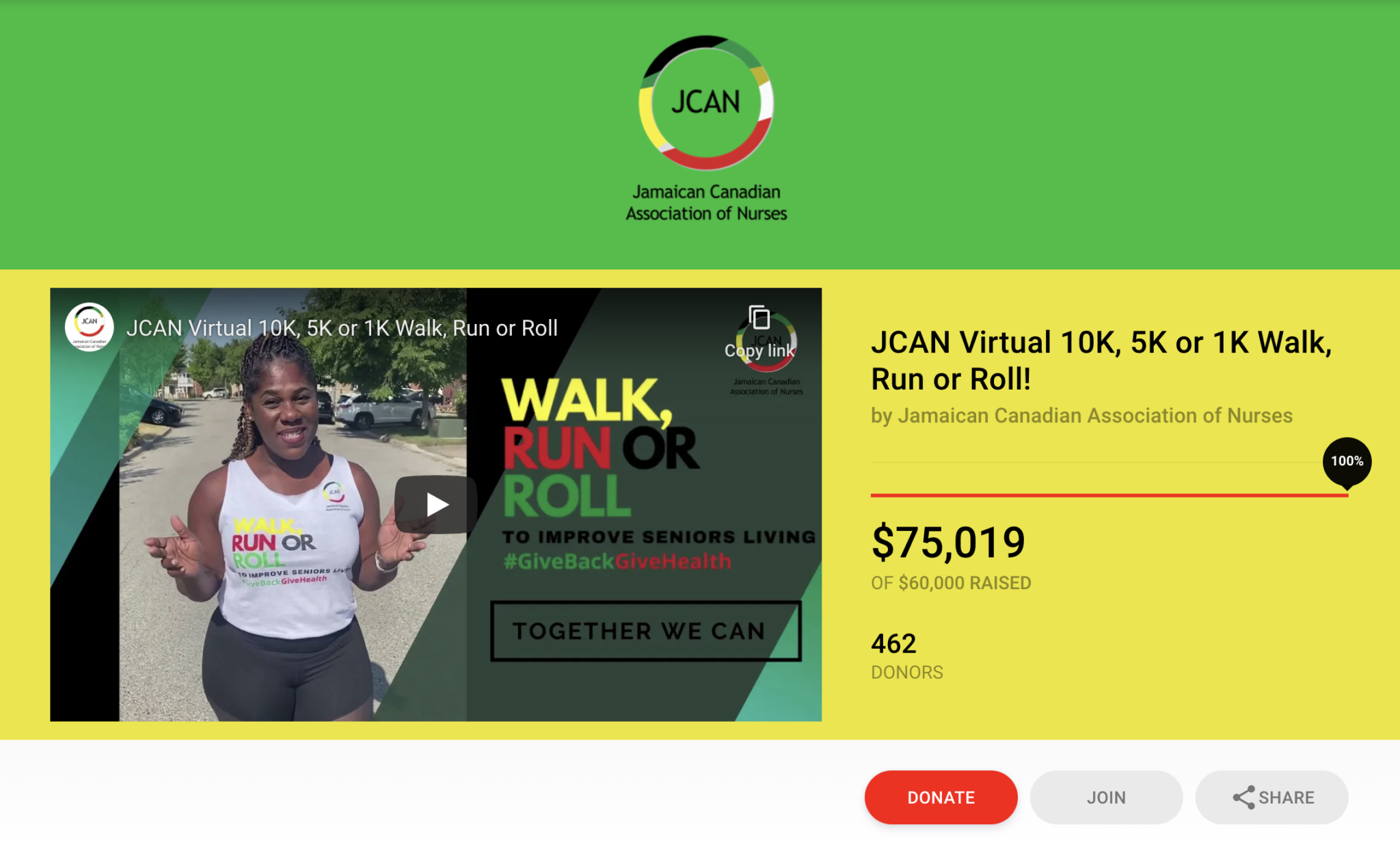
Here’s what we think made their virtual fundraising event stand out:
- They connected their mission with the current COVID crisis to help donors feel the timeliness of the event.
- They made sure to create an event that was inclusive by calling out folks who use mobility devices and inviting them to join. This is especially important because the event was benefiting seniors, a group more likely to need mobility aids.
- Everything about their branding and event choices tied back to the work they do and the story they were telling, such as incorporating a heavy use of images, testimonials, and videos onto the page.
- They charged $25 per participant that created a page to offset event costs
That inclusiveness was a huge part of the success of this event. JCAN put their clients at the heart of the event, from the marketing around the impact of COVID to the actual set up of the event (anyone could participate in any way they chose, at a variety of distances). This constant reminder that they were working to help seniors inspired donors to get involved.
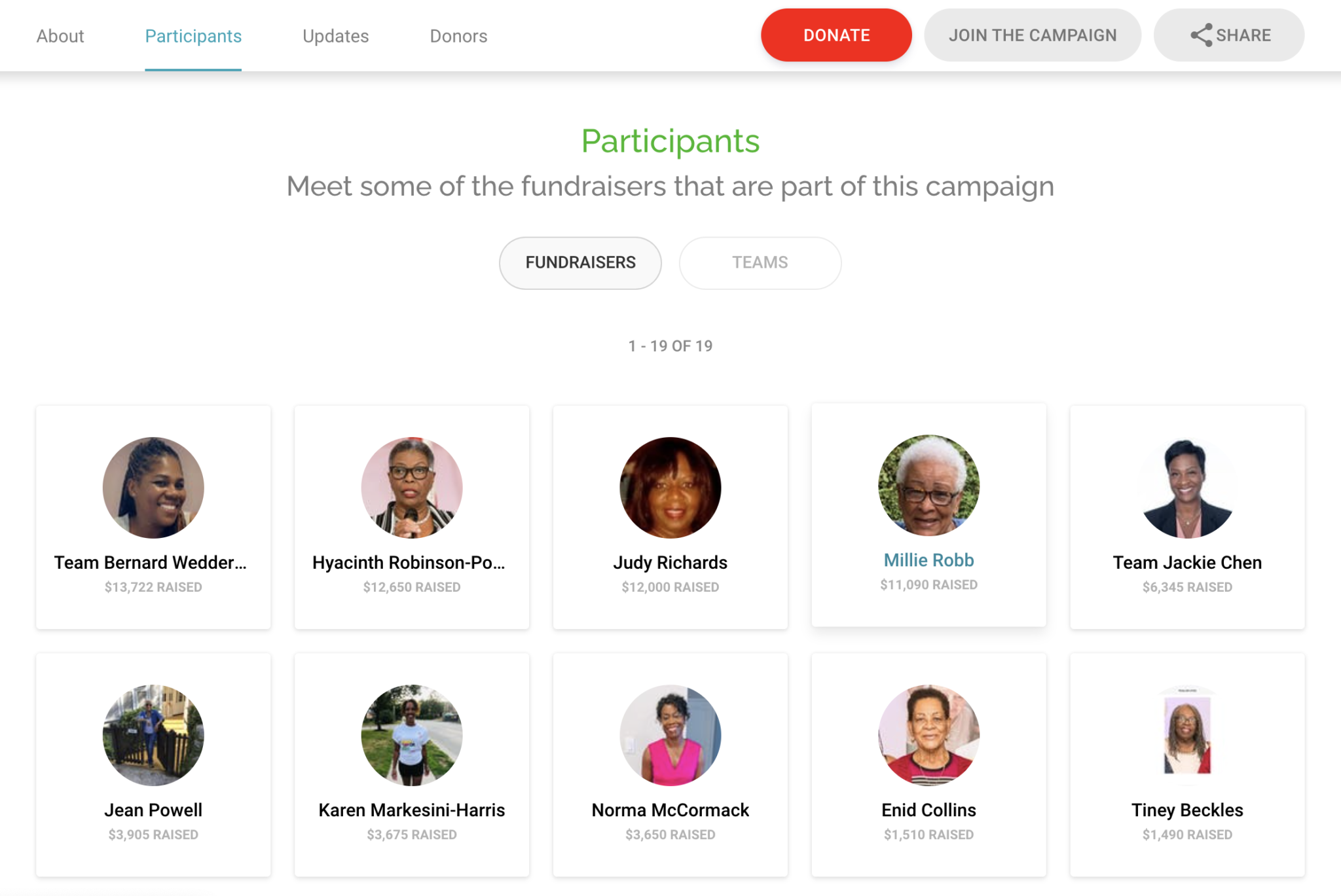
Why it worked:
- They activated their board, staff, and key members of their community to create personal fundraising pages to fundraise. Even though they only had 19 participants, they were the RIGHT 19 participants that helped them collectively exceed their goal of $60,000, raising over $75,000 for their mission.
- They gave participants of different capabilities different options: Not only could they run, walk, or roll, they could also choose a distance that works for them: 10k, 5k, or 1k.
- JCAN knew their community, who is generally older and less tech-savvy, needed a tool that was easy and clunk-free. They chose to use CauseVox to make it easy for their participants to sign up in < 60 seconds.
- They encouraged social sharing with their hashtag #GiveBackGiveHealth
- They increased competition by offering prizes based on engagement.
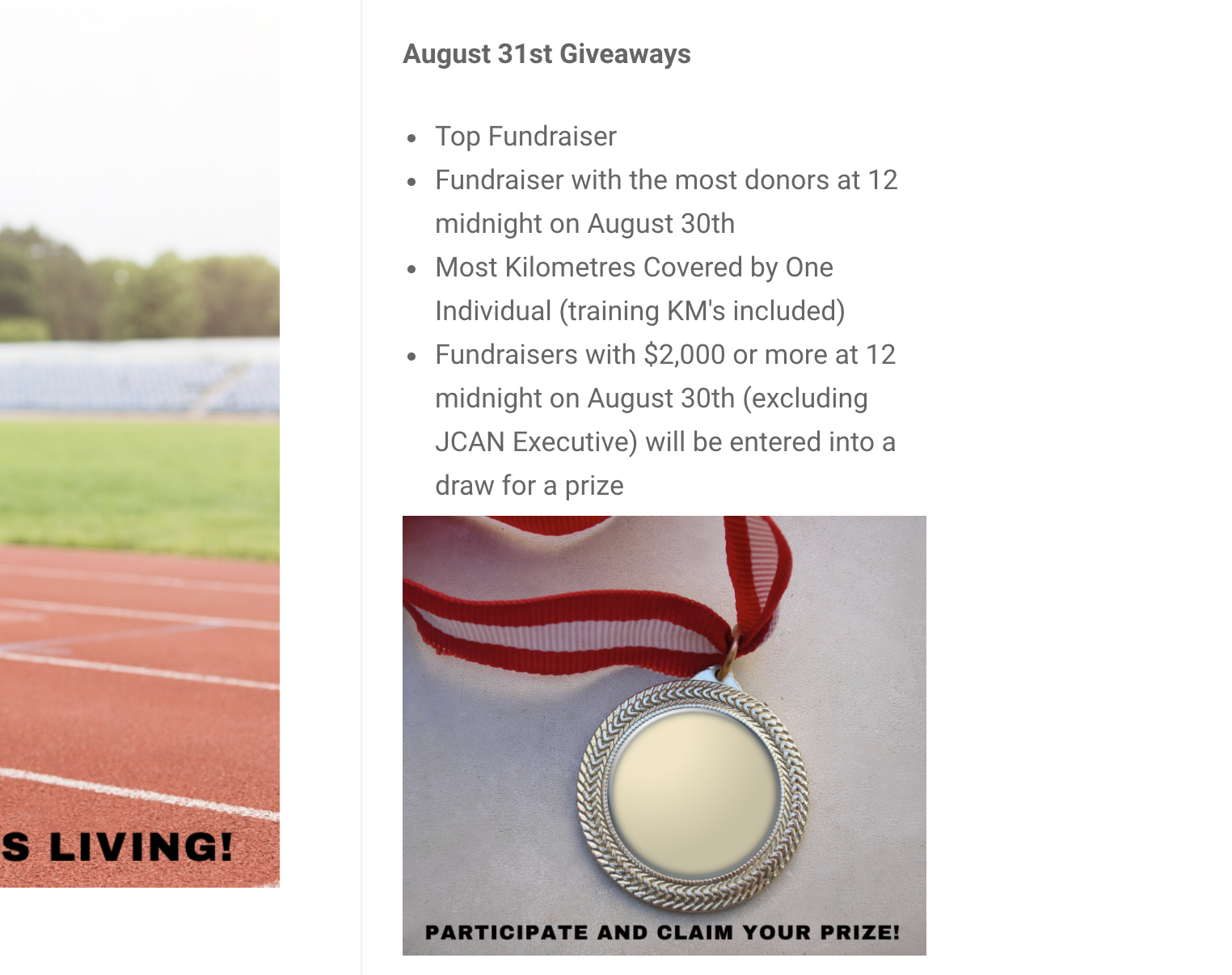
2. Parkinson’s Nebraska’s Walk The State Challenge
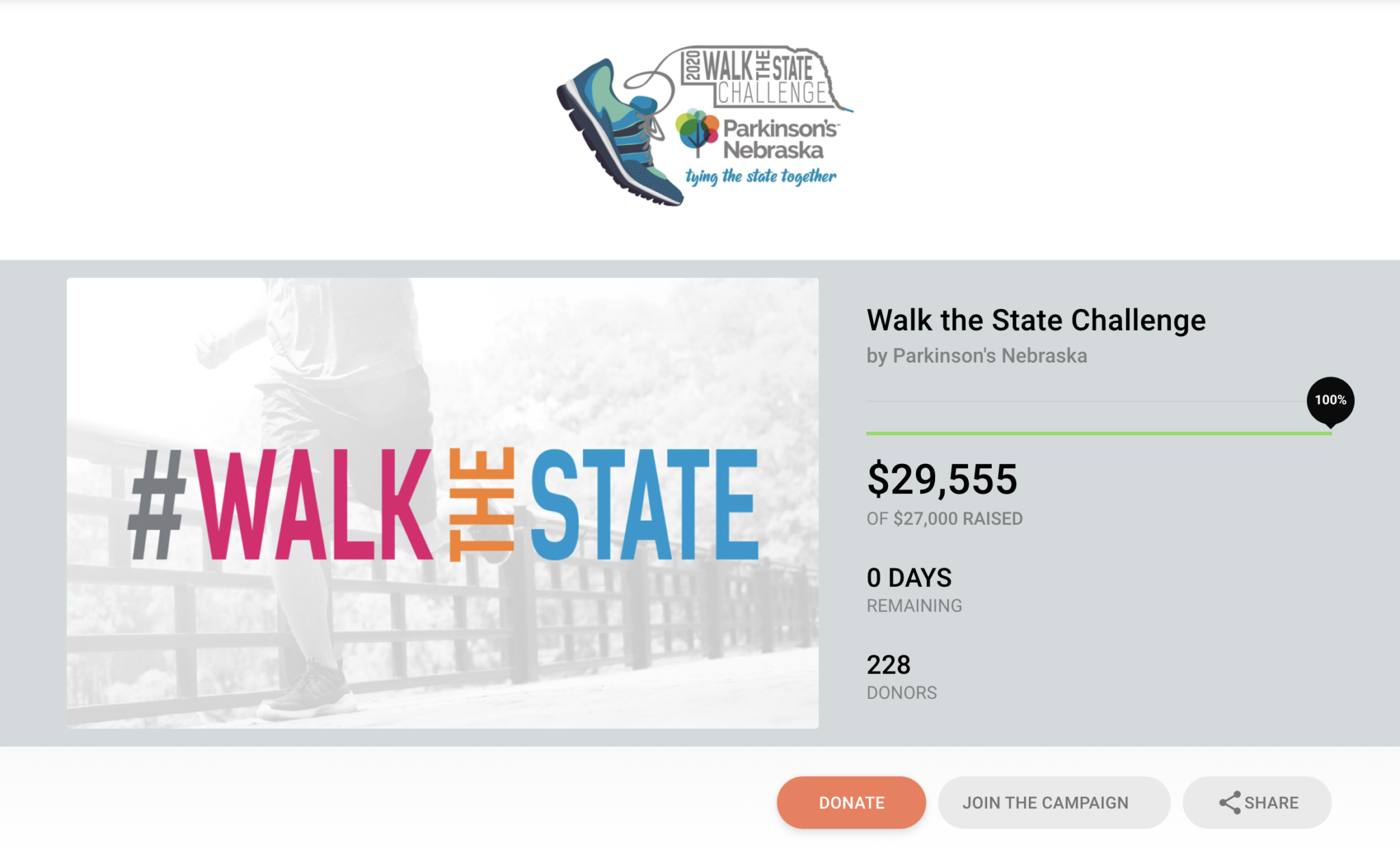
Parkinson’s Nebrasksa got really creative with their virtual walkathon. They used COVID as an opportunity to try something that would have been impossible in person: they asked their supporters to collectively walk the width of Nebraska.
This was an amazing way to pivot to virtual and use the distanced format to do something new and unique. Not only that, it tied directly into who they were: a state-based organization.
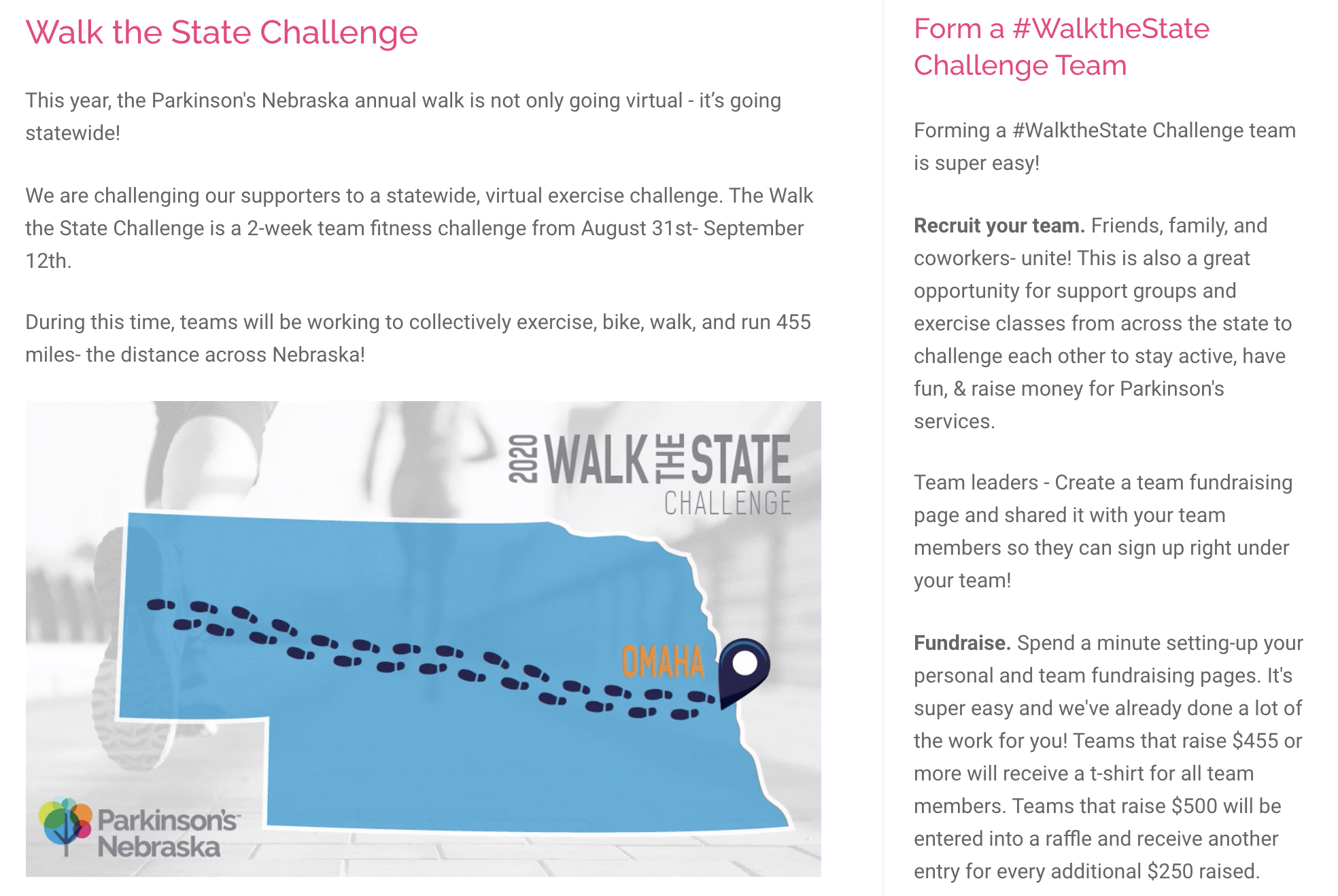
What made their virtual walkathon stand out:
- Their event culminated in a livestream on Zoom, encouraging all the participants, friends, and family to join to celebrate live.
- There was no fee for participation. Instead they encouraged individual and teams to raise a minimum amount, and offered raffle entries for those that met their goal, as well as additional entries for those that exceeded it.
- They sold t-shirts alongside the event on their website.
- They were able to recruit sponsors and displayed their sponsor logos on the campaign site on CauseVox
Why it worked:
- One of the primary things Amber from Parkinson’s Nebraska said contributed to their success was creating a fundraising toolkit for participants. Amber invested a lot of time into preparing a toolkit, which provided them everything from a promotional calendar, to social media posts, drafted emails and more. This made it really easy for participants to promote their personal fundraising pages. Check out her amazing toolkit here.
- It played on people’s competitive spirits to get them going. They wanted to hit that 455 miles, and nothing was going to stop them.
- The 455 miles goal allowed the organization to create clear visuals to show their progress and motivate fundraisers.
- It helped raise awareness about the importance of exercise for Parkinson’s by putting exercise at the heart of the event.
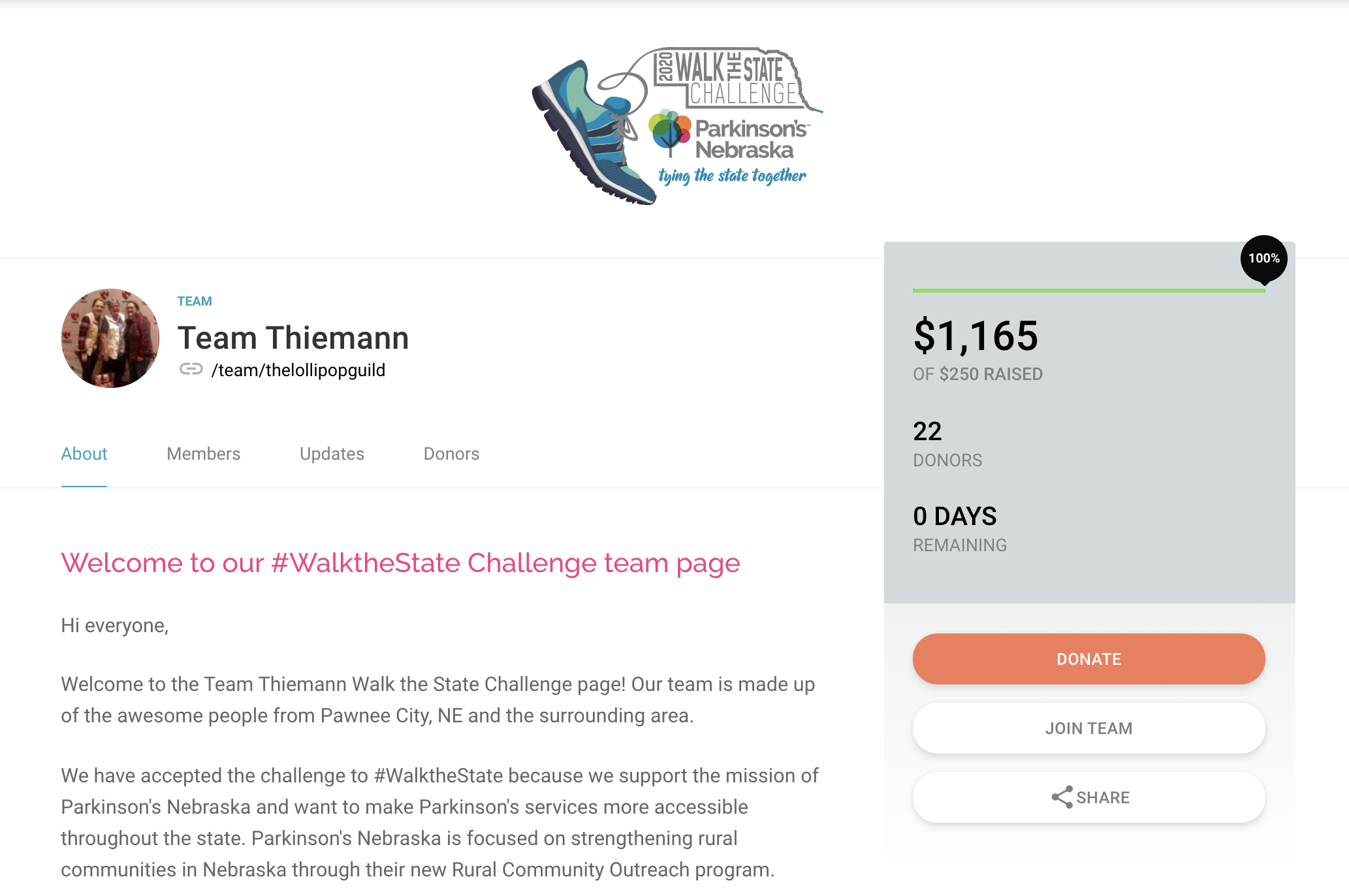
3. Postpartum Support International: Climb Out of the Darkness 2020
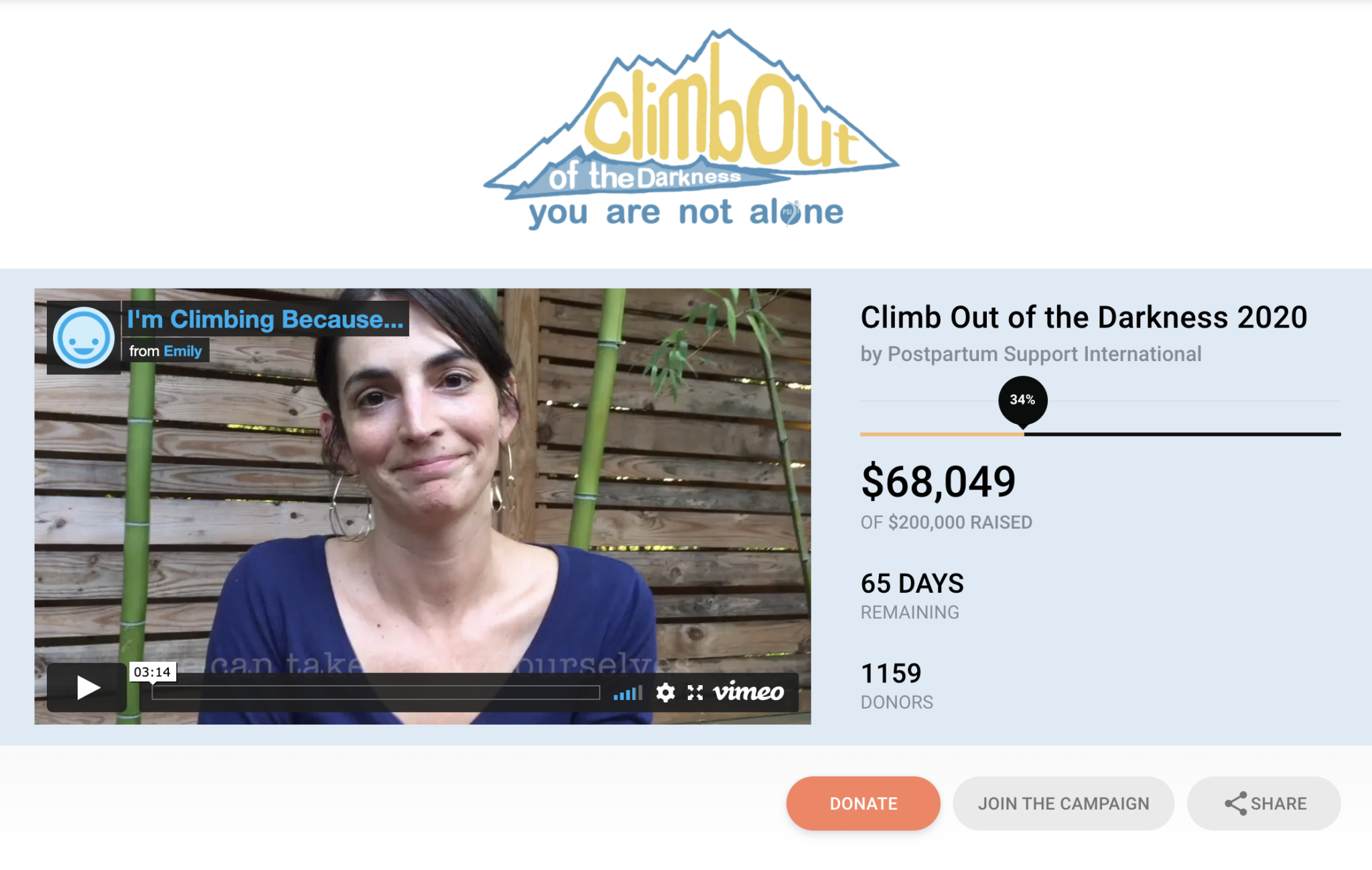
We absolutely LOVE the creativity of this event. While most physical activity fundraisers are walks, runs, or bikes, Climb Out of the Darkness is a climb. Participants can find a location near them to climb or hike to the top of a mountain to raise money and bring awareness to postpartum mental illness.
This campaign is still in progress, but they’ve already raised over $67,000 of their $200,000 goal.
Here’s why we think this event stands out:
- They chose an activity that is different! Climbing is something you don’t do every day, and draws in new folks.
- Their activity is incredibly photogenic: climbing definitely gets likes on the gram, and thus more shares.
- There are climbs across the world, and they highlighted this in their welcome video by including people speaking multiple languages.
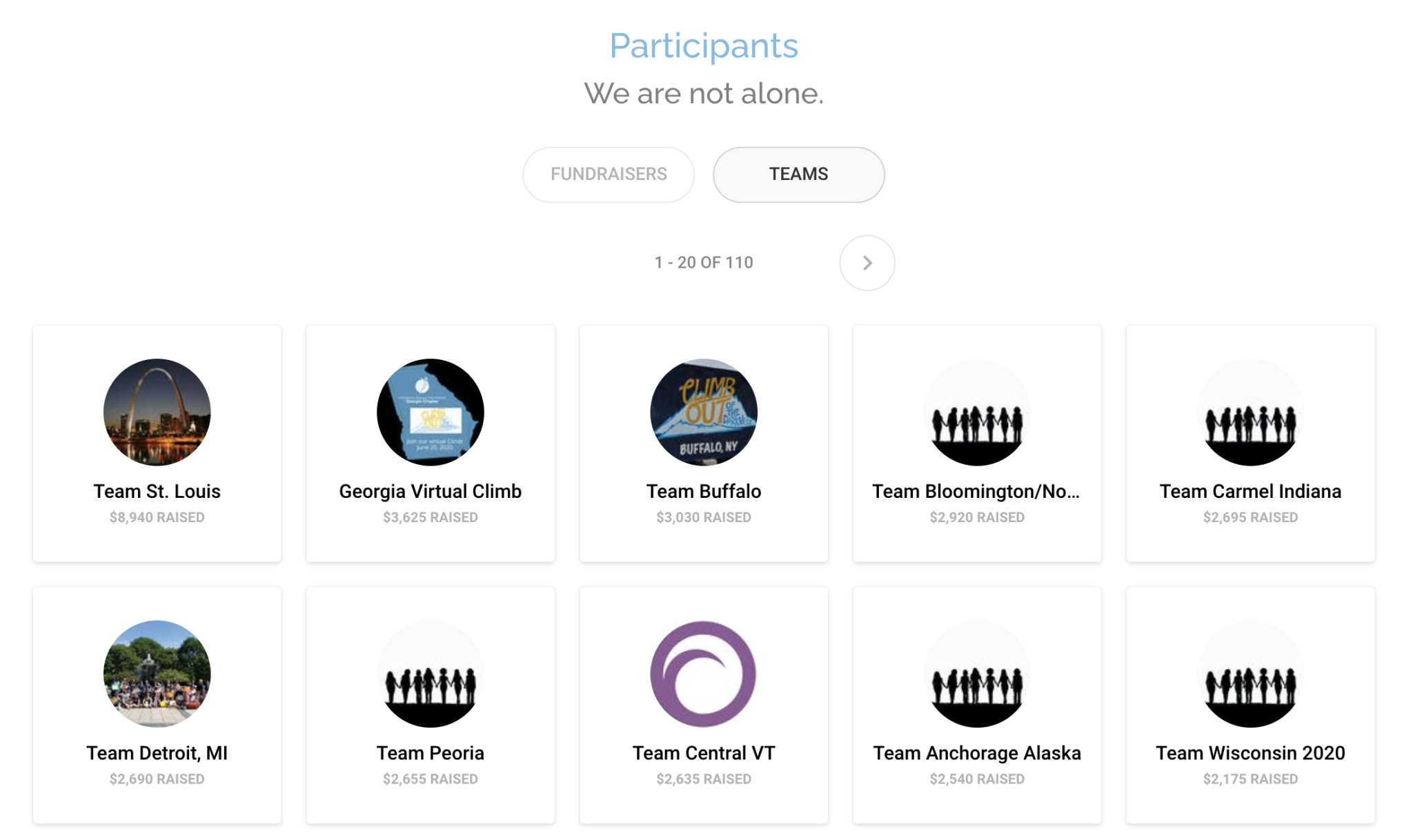
Of course there are still over two months left for Postpartum Support International to hit their goal, but they are well on their way. There’s a few reasons they’ve been successful so far:
- Their event parallels their cause. Dealing with depression or anxiety can feel like climbing out of a depth or a pit. Encouraging supporters to literally climb helps to remind them of the struggles Postpartum Support International’s clients face. It’s a fun activity that still centers the mission and tells a strong story.
- They harnessed the power of communities. Because there are climbs around the world, Postpartum Support International tapped climb leaders in each area to lead the way and form Teams. These local leaders motivated supporters and brought their networks in to participate.
- They used CauseVox’s streamlined page to funnel all those different events and supporters to one place with consistent branding and language.
- They truly harnessed the power of peer-to-peer fundraising with 666 people raising money.
- They incentivized people by giving a free t-shirt to anyone that raised $100, which helped to give people a clear goal.
4. N Street Village’s 2020 Virtual SHERO Walk
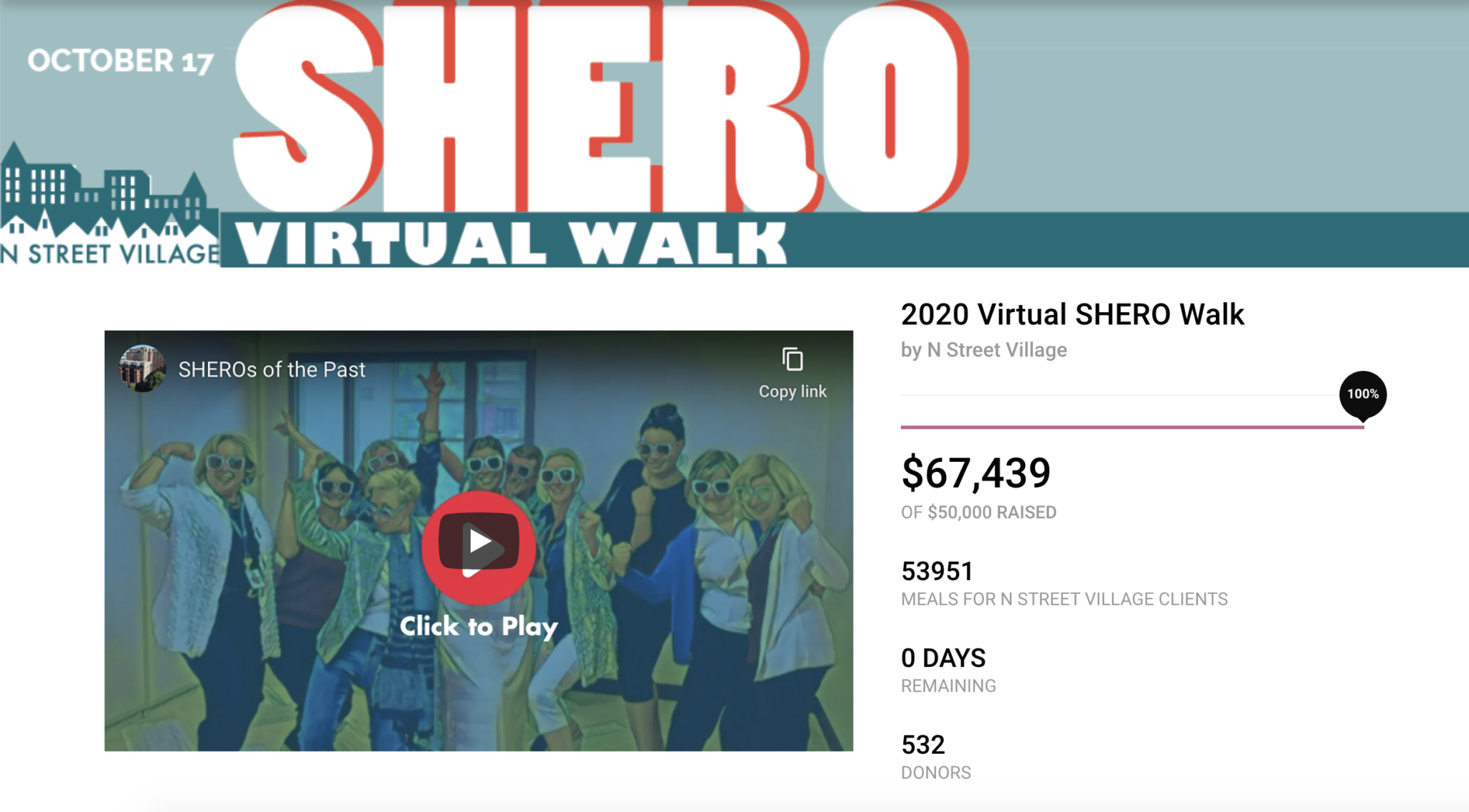
N Street Village blew us out of the water (and they blew their goal out of the water) with the way they used their online event to build community. They hosted a virtual walk and finished off their campaign with a live-streamed program to bring together all the supporters.
Thanks to their focus on the people in their neighborhood, they raised over $67,000 (easily passing their goal of $50,000) to provide resources to homeless individuals in the community and housing for those living with HIV and AIDS.
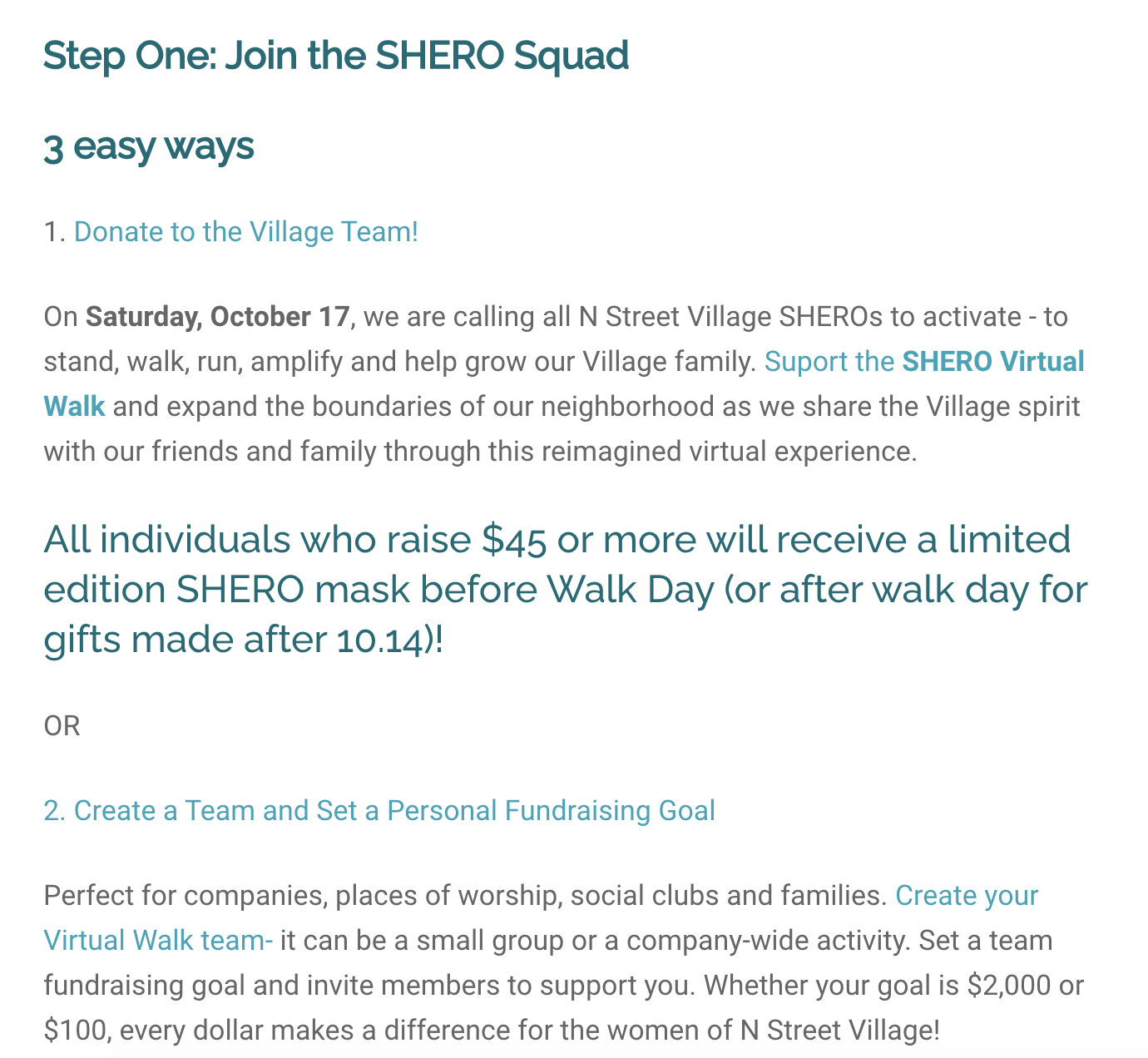
Here’s what set them apart:
- A strong focus on teams, community and connection.
- Clear language to encourage families, corporate groups, and clubs to create teams.
- Super fun branding (who doesn’t want to be a Shero?).
That unique element also helped to launch their success. Let’s check out what else helped them to be successful:
- They provided custom toolkits to community partners and families/students.
- They made it fun to participate: they encouraged costumes, themes, and silliness. Plus, they used prizes to incentivize participation.
- They got their executive director involved: in the intro video, she dresses up as “Shrelvis” (the Shero Elvis), dances, hoots, hollers, and gets goofy.
- They clearly showed their impact using CauseVox’s donation tiers and impact tools. You can see right at the top of their page they have listed the number of meals the fundraiser will provide.
- They created super fun sponsor tiers like “Avenger” and “Defender” to incentivize participation.
- They used CauseVox’s peer-to-peer capabilities to allow teams and individual fundraisers, and boy was that successful. They had 111 individuals join, and 13 teams. The teams in particular were incredibly successful and showed how powerful it is to ask groups to fundraise together.
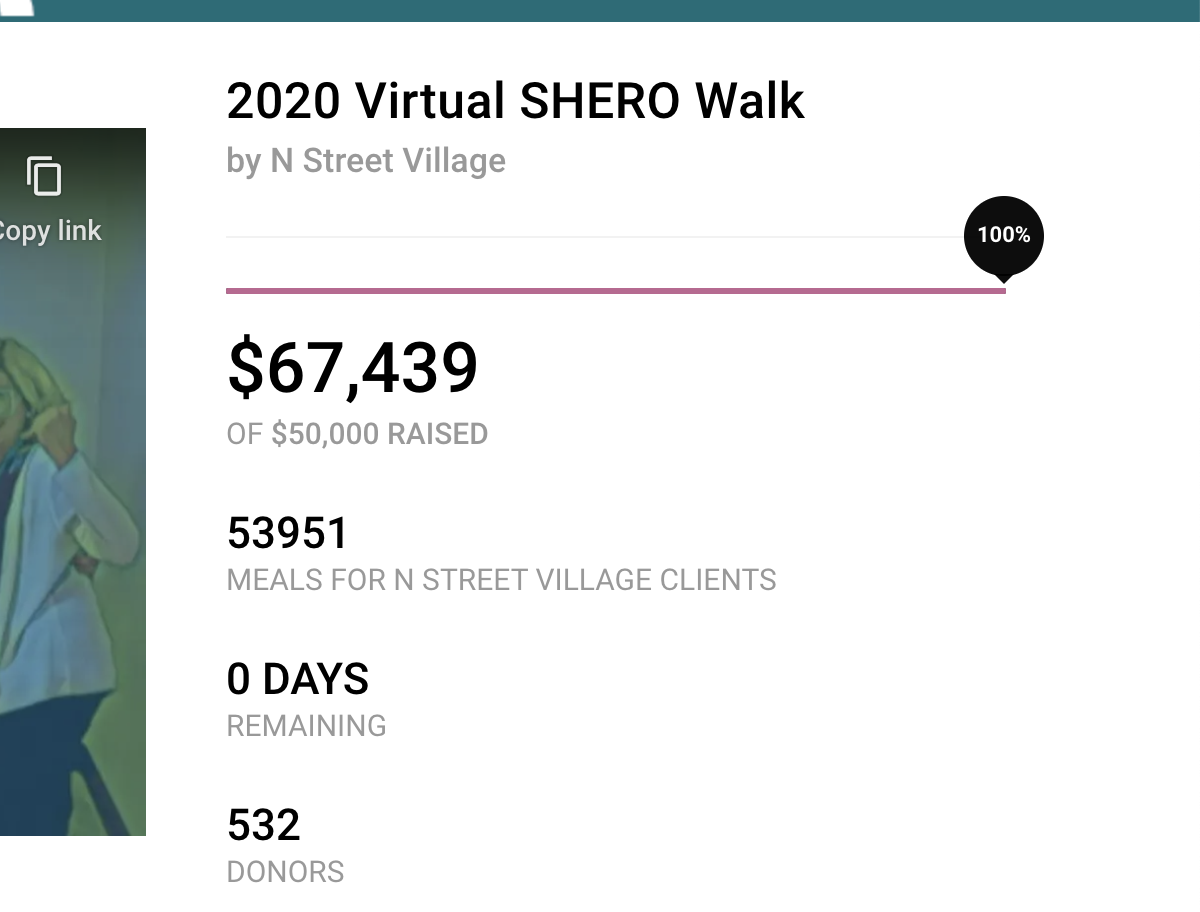
5. Education Matters Africa’s 20ForUSAP@20 | Run/Walk/Cycle
Education Matters Africa Foundation took a really clever tactic with their virtual event. They were celebrating their 20th anniversary and asked fundraisers to join in by running, walking, or biking 20 miles. It turns out their snappy branding was very effective because they raised over $68,000 (of a $50,000 goal) for their community school in Zimbabwe.
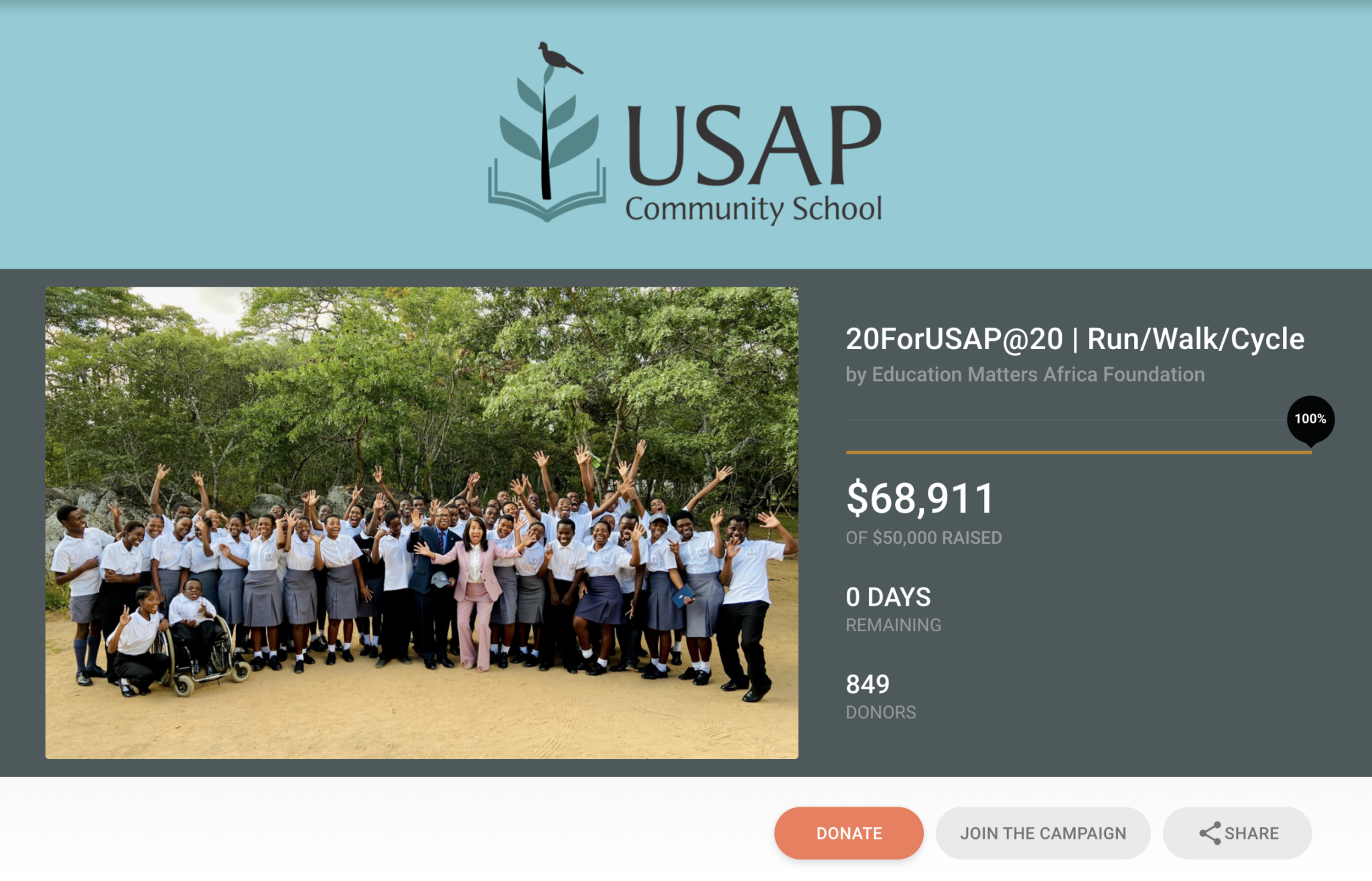
What made them stand out?
- They gave fundraisers one clear, easy to remember number and slogan.
- They framed the event as a celebration of their anniversary rather than just a fundraiser.
- Their slogan was oh so shareable and they encouraged people to use the hashtag #20forusap on social.
- They focused their messaging around the impact the organization is making.
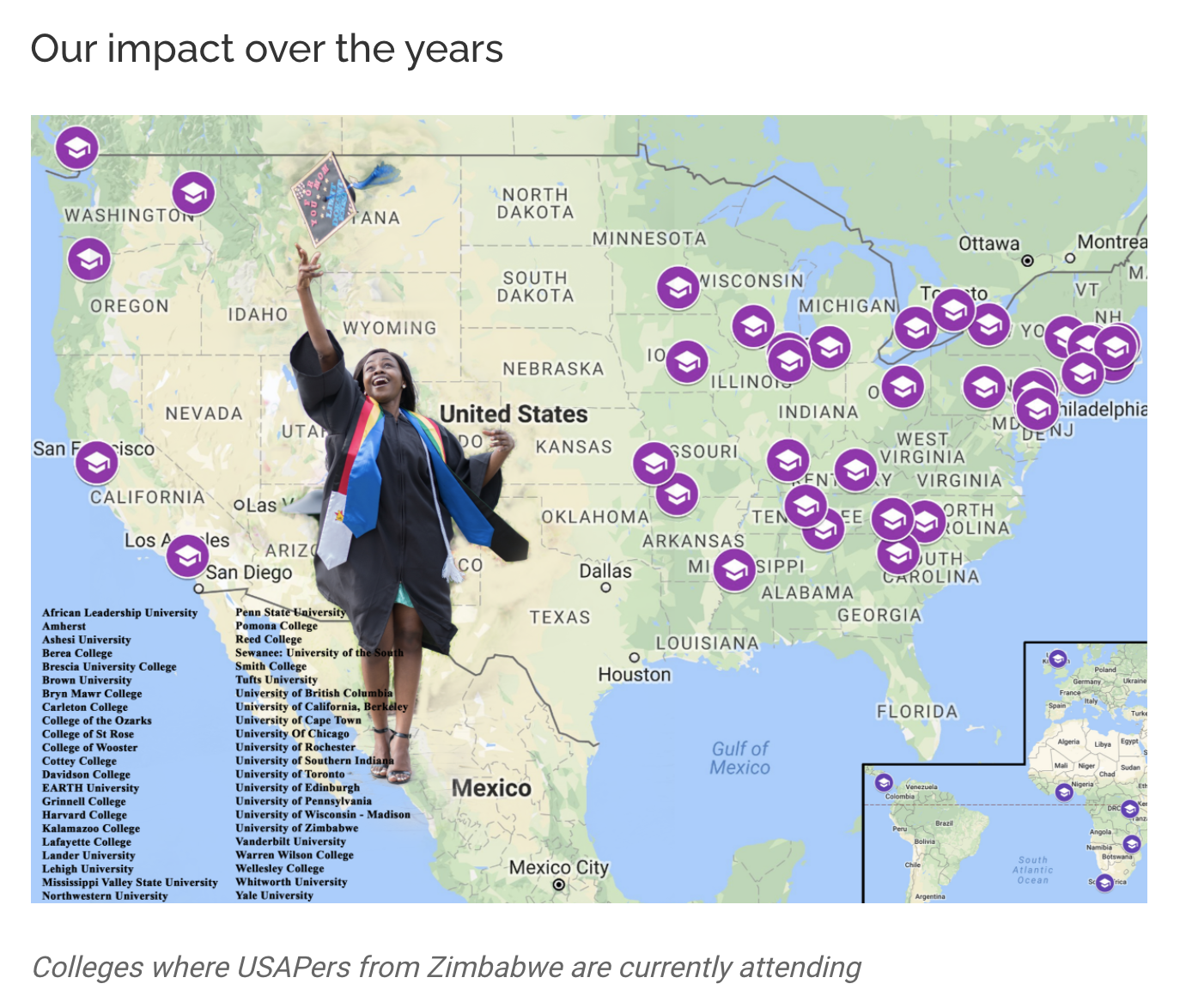
And why was all that so effective?
- The slogan was a great motivator that stood out in participants’ minds.
- They highlighted their longevity, which communicates their trustworthiness.
- The whole campaign was incredibly cohesive in the way it used the 20 year anniversary. That consistent branding made it memorable.
- They used the power of a matching grant. Partway through the campaign they announced that they had a $50,000 matching grant to keep the campaign running strong.
- They had 84 fundraisers take part in their peer-to-peer fundraising. Some of those individuals were graduates of their program, which made their fundraising even more powerful.
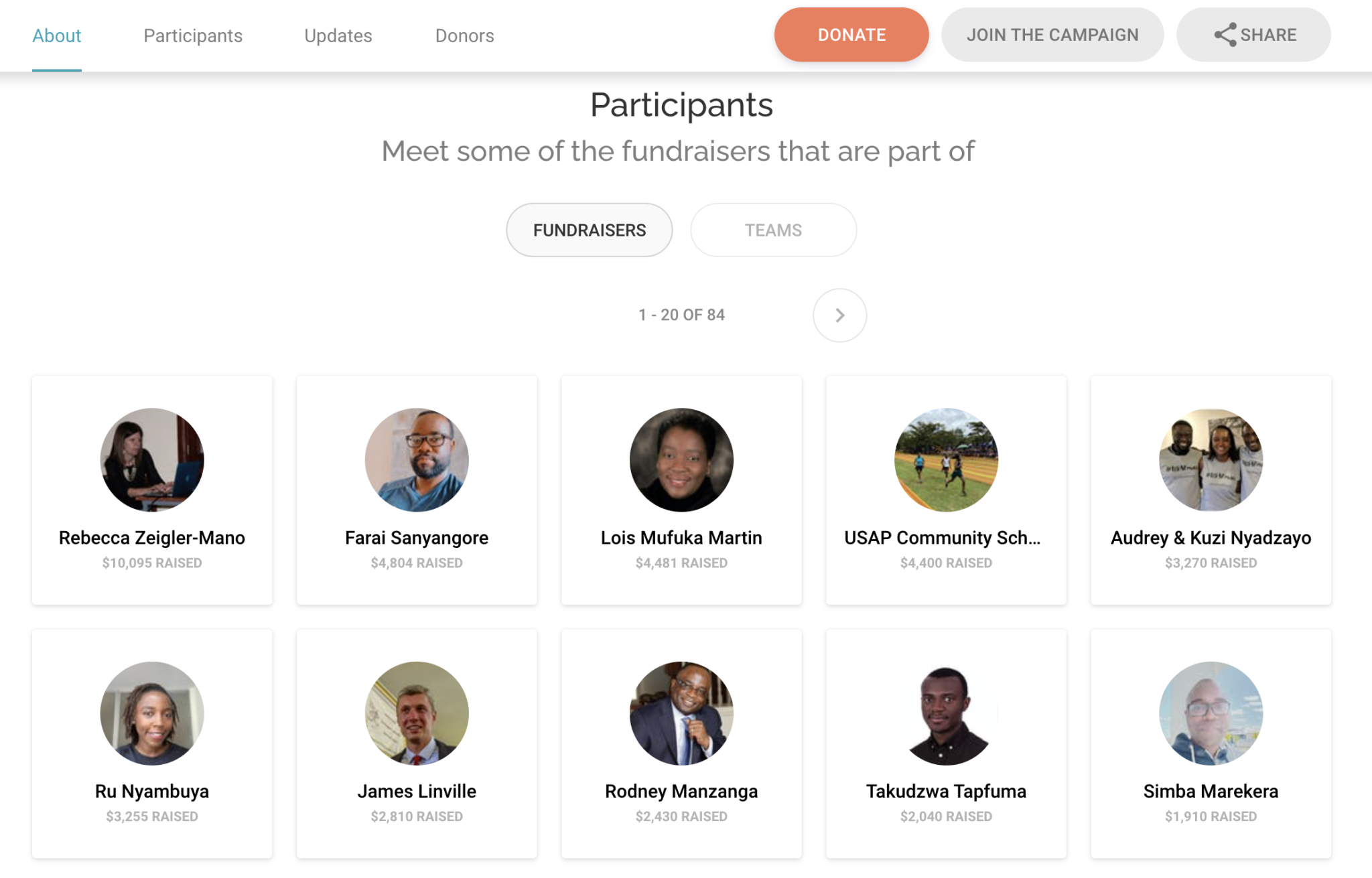
6. Can Do Canines Can Do Woofaroo
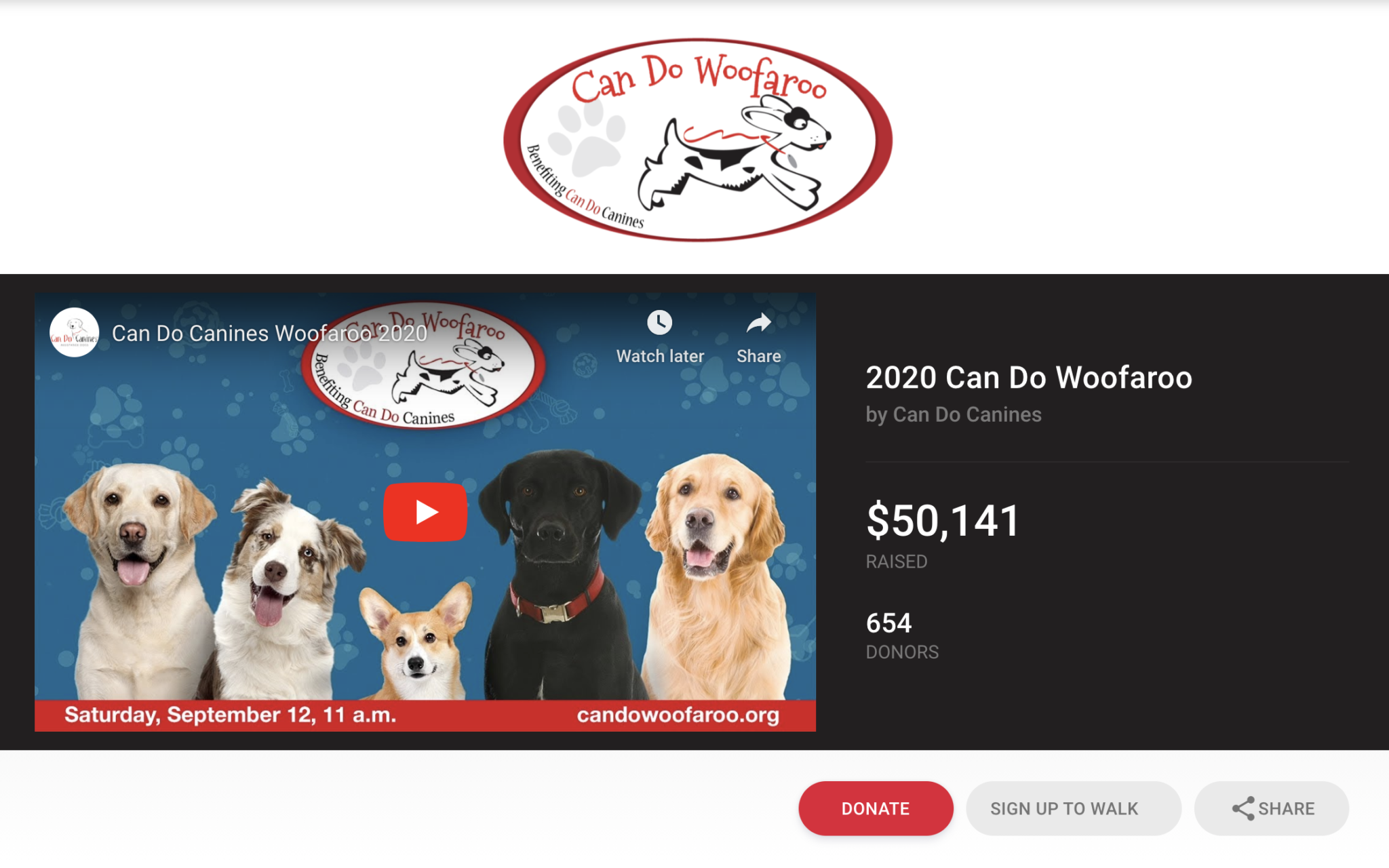
I will say upfront that Can Do Canines has an unfair advantage over the rest of us because they have highly trained dogs and puppies that they can use in their videos. This is unbearably cute and donors cannot resist.
Their annual event and walk raised nearly $50,000 for service dogs. Those canines really know how to bring in the big bucks.
However Can Do Canines is successful for a lot of reasons beyond the pups. Here’s what really made their Woofaroo stand out:
- Tons of prizes and interactive opportunities including a costume contest, name-a-puppy contest, and fundraising prizes.
- Many different ways to participate, including the opportunity to get a caricature with your pet (so cool!!!).
- A top notch sponsor lineup
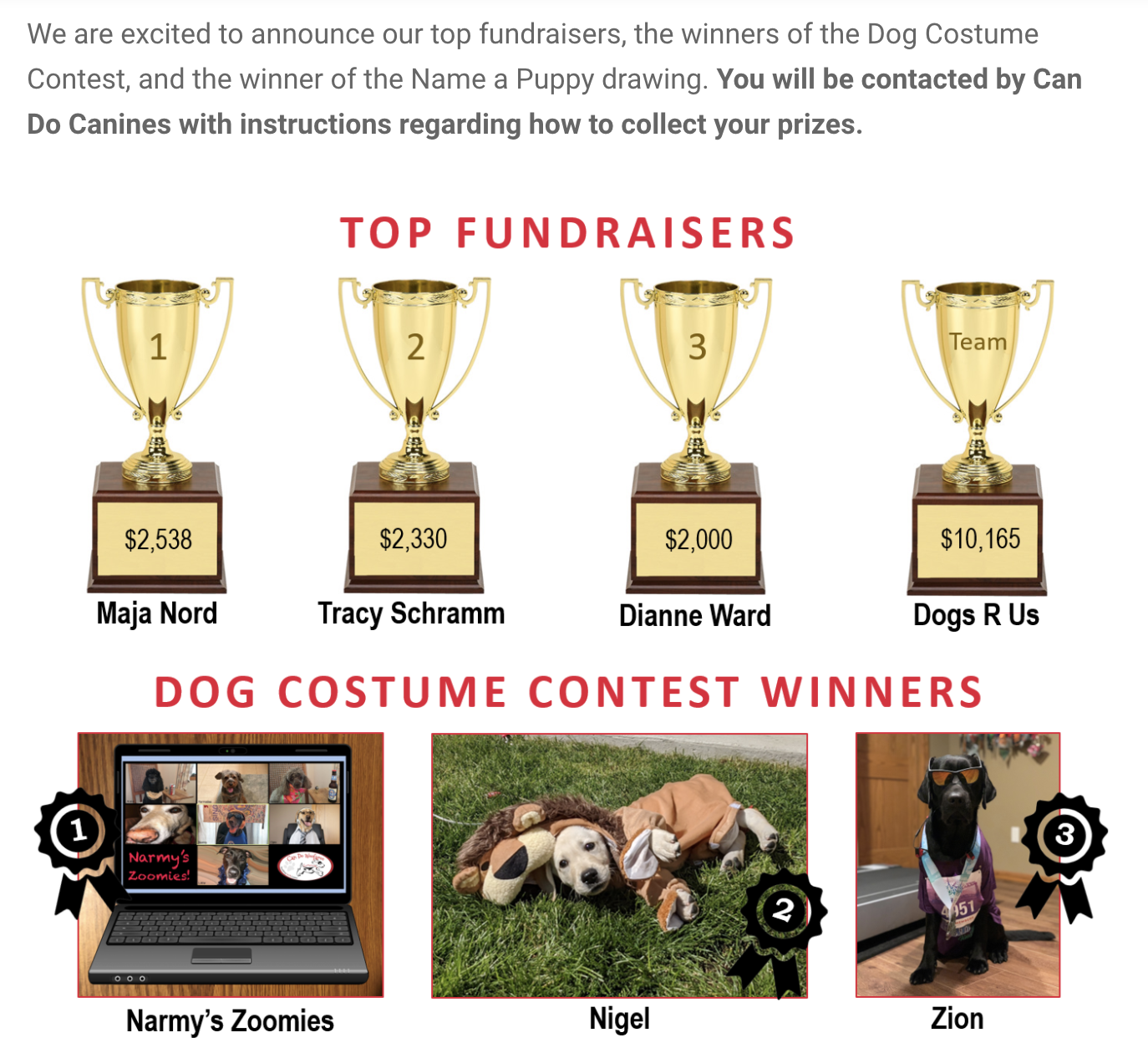
With all of that, we learned a few things about how to make a successful event:
- Make your livestream fun. The Woofaroo included “assistance dog demonstration, Can Do Canines client presentation, dog costume contest, a very special piece featuring our prison inmate dog training program, cute puppies, and all kinds of fun surprises!”
- All in one fundraising page: supporters could watch the program right there on the Can Do CauseVox page, then make a donation without going anywhere.
- Tons of interaction: they highlighted winners, built in contests, and went above and beyond to highlight their supporters.
- Their peer-to-peer fundraising had both teams and individual fundraisers, totalling 119 participants. Instead of giving fundraisers a goal number, they incentivized fundraising through their prizes: supporters could earn fun branded merch by raising $50, $125, or $500.
Gala/Awards Ceremony
Galas, luncheons, award ceremonies, and other fundraising evenings have been a struggle this year. It can be tough to recreate the feeling of excitement and fun that an in person event has. Of course that hasn’t stopped the intrepid nonprofit fundraisers of the world. Seriously, you guys are incredibly resilient.
A lot of organizations have turned to livestreaming their galas to make them virtual, making them what we affectionately call an “Ungala”. We’ve broken down the steps of how to plan a virtual gala, so here we’ll highlight some of our favorite examples and what worked well for them.
7. Planned Parenthood of Metropolitan Washington DC’s Virtual Impact Gala 2020
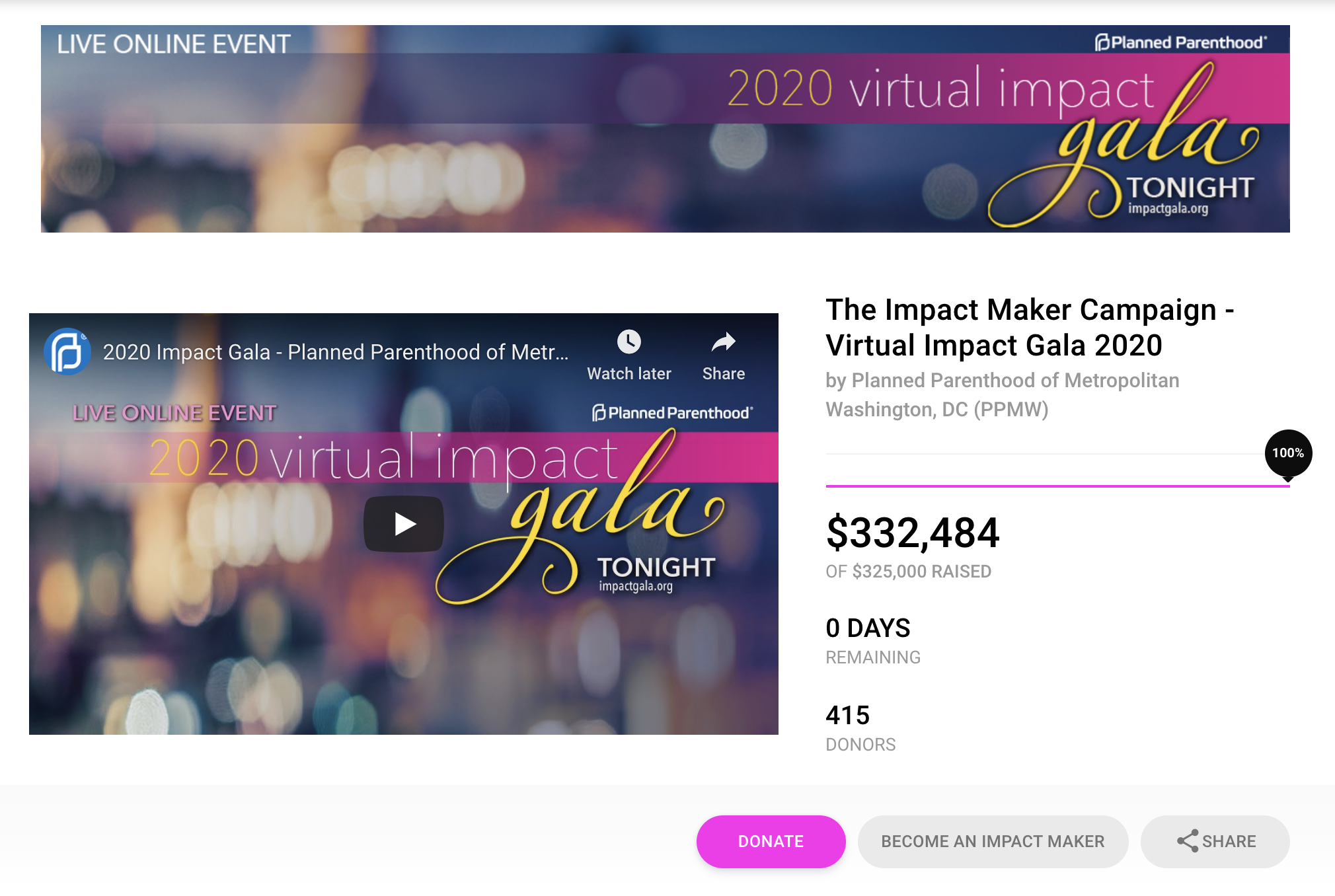
Planned Parenthood of Metropolitan Washington, DC took a look at virtual events and decided that they could find a way to make it feel like the in-person event. Boy howdy did they succeed.
In order to recreate the feeling, they asked supporters who typically would purchase a table to act as “table hosts” and start fundraising teams for peer-to-peer fundraising. They held a live-streamed program, and made sure that it had plenty of opportunities for engagement.
Viewers could comment or ask questions, and chat virtually. With all this, they surpassed their goal of $325,000 by over 7 grand. Let’s take a closer look.
Why did it stand out?
- They worked with a local restaurant, Founding Farmers, to create a menu for the evening. Participants could order dinner to be delivered at home so they could eat while watching the gala.
- They created the feeling of a “night out” through virtual. During a year when we’re all stuck inside, that was pretty appealing.
They also did so many things right to make this night a success:
- They created short, shareable videos like the one above to highlight how they were responding to COVID.
- They asked table hosts to act as peer-to-peer fundraising team captains, and built a gorgeous fundraising page template through CauseVox. These team captains help to bring in 50 fundraisers to support the event.
- They provided a chat function so that viewers could stay engaged during their program.
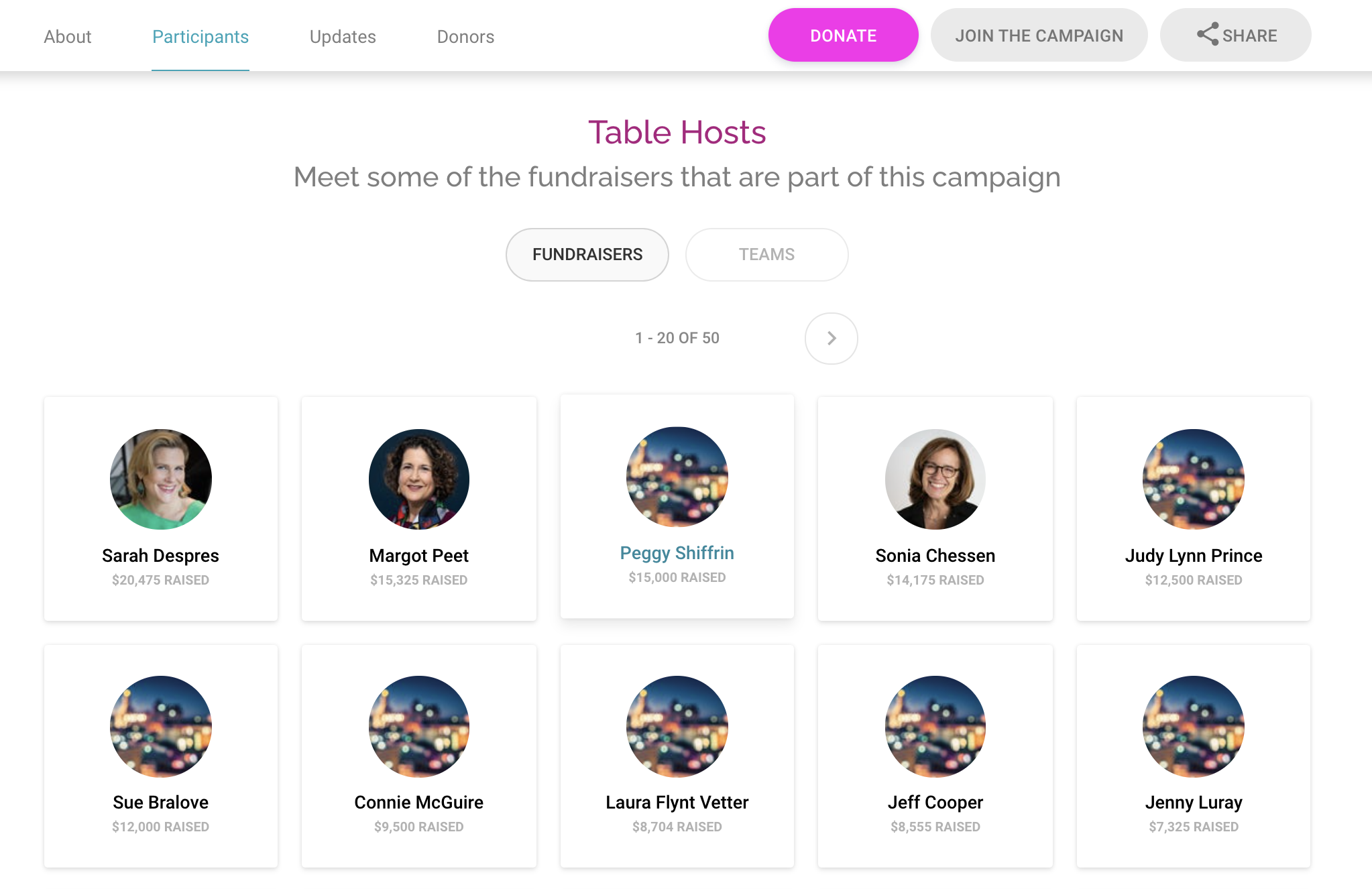
8. Summit Assistance Dogs’ Unleash Your Love Virtual Luncheon
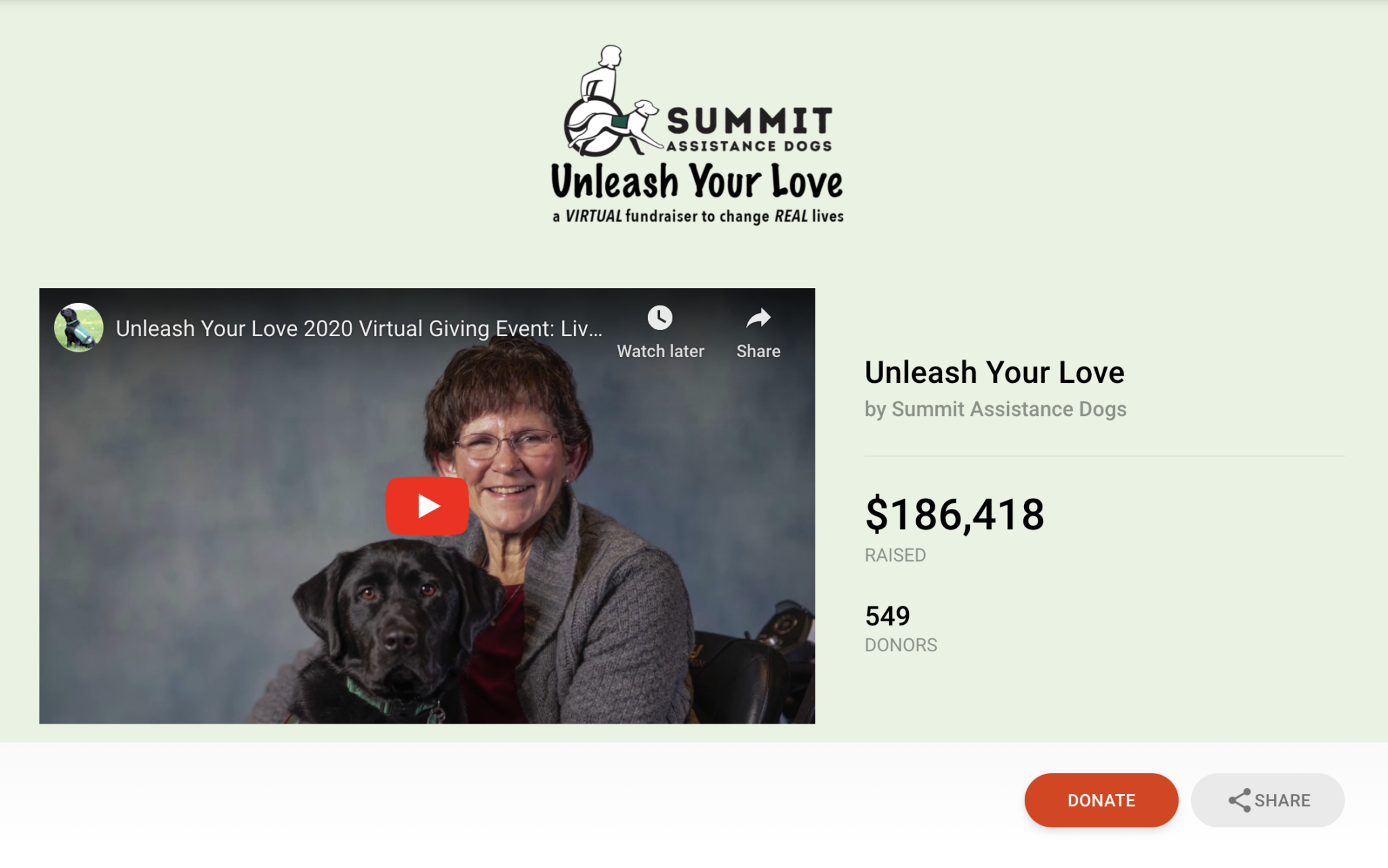
The Unleash Your Love luncheon is hosted by Summit Assistance Dogs each year, but when COVID hit they had to make a fast pivot to a virtual event. They quickly built up a peer-to-peer fundraising campaign that would allow strong fundraisers to act as table captains. They created a digital space that acted as a community hub, pushing all their supporters to their CauseVox page throughout the campaign.
Through all of this, they ended up increasing their ROI by eight times the previous year. Their final total was over $186,000, over $11,000 more than their goal.
A few things made this campaign one of our favorites:
- Summit Assistance Dogs used CauseVox’s update feature to share information about how the fundraising was going leading up to the event. They shared clips of what they were doing. They let people know when they hit goals, or when they were getting close.
- They built up their CauseVox page as a community hub by sharing videos, pictures, and stories to highlight the voices and partnerships of clients and their dogs. Clients read letters they wrote to their dogs, or letters from those who participate in Summit’s prison program training dogs.
And all of this turned into success through a few important elements:
- Strong fundraiser support. They created a robust toolkit for their fundraisers that made it easy to get started.
- Personal stories: not only did they share personal stories on their main CauseVox page, they also created a fundraiser template that included photos and videos to draw in donors.
- Donation tiers! Summit Assistance Dogs did a fantastic job of using donation tiers to highlight how a donation would make an impact.
- The updates feature: many people underestimate the power of sharing updates, but Summit Assistance Dogs kept people engaged by sharing new information regularly.
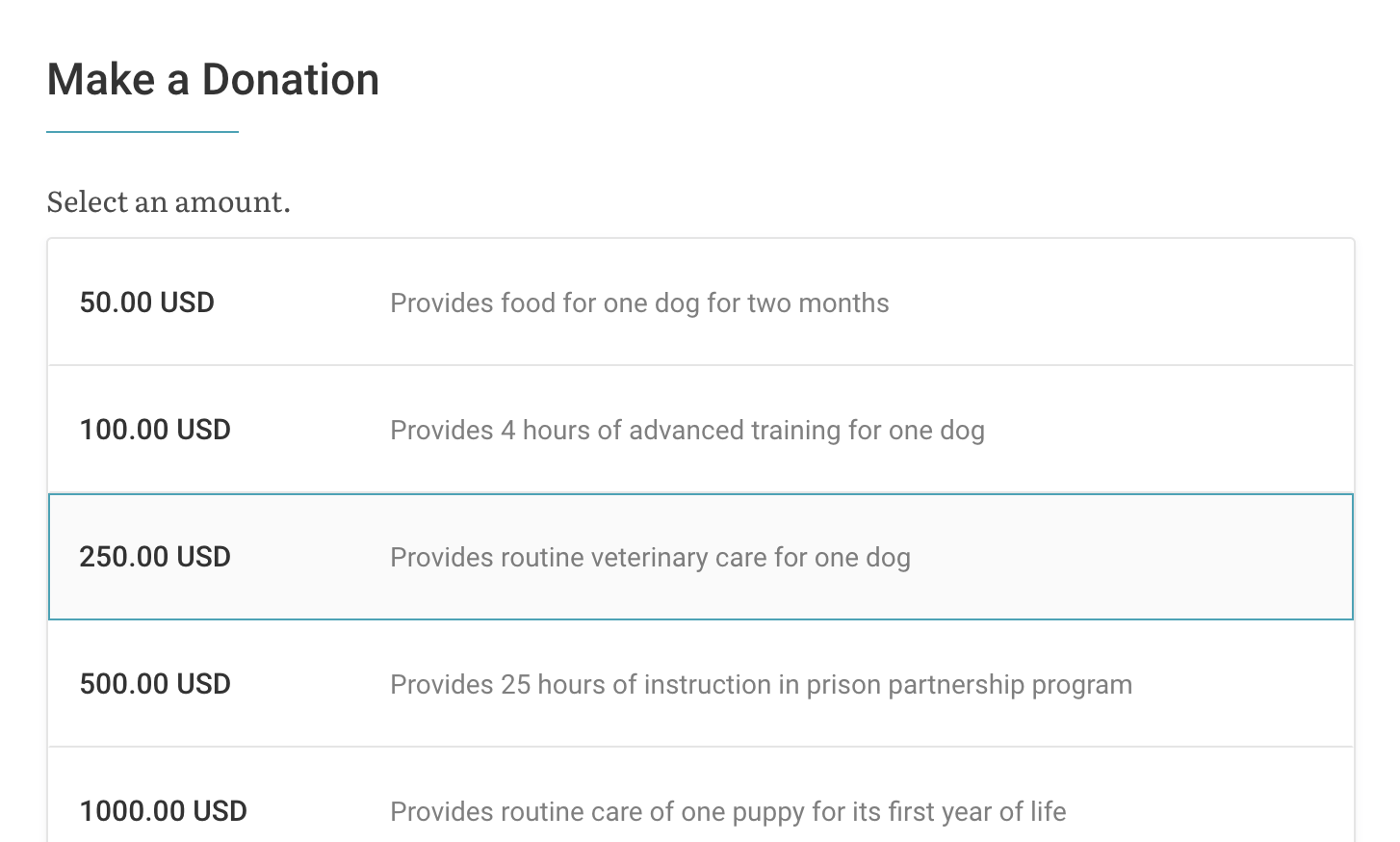
9. Woven Health’s Virtual Awards Celebration
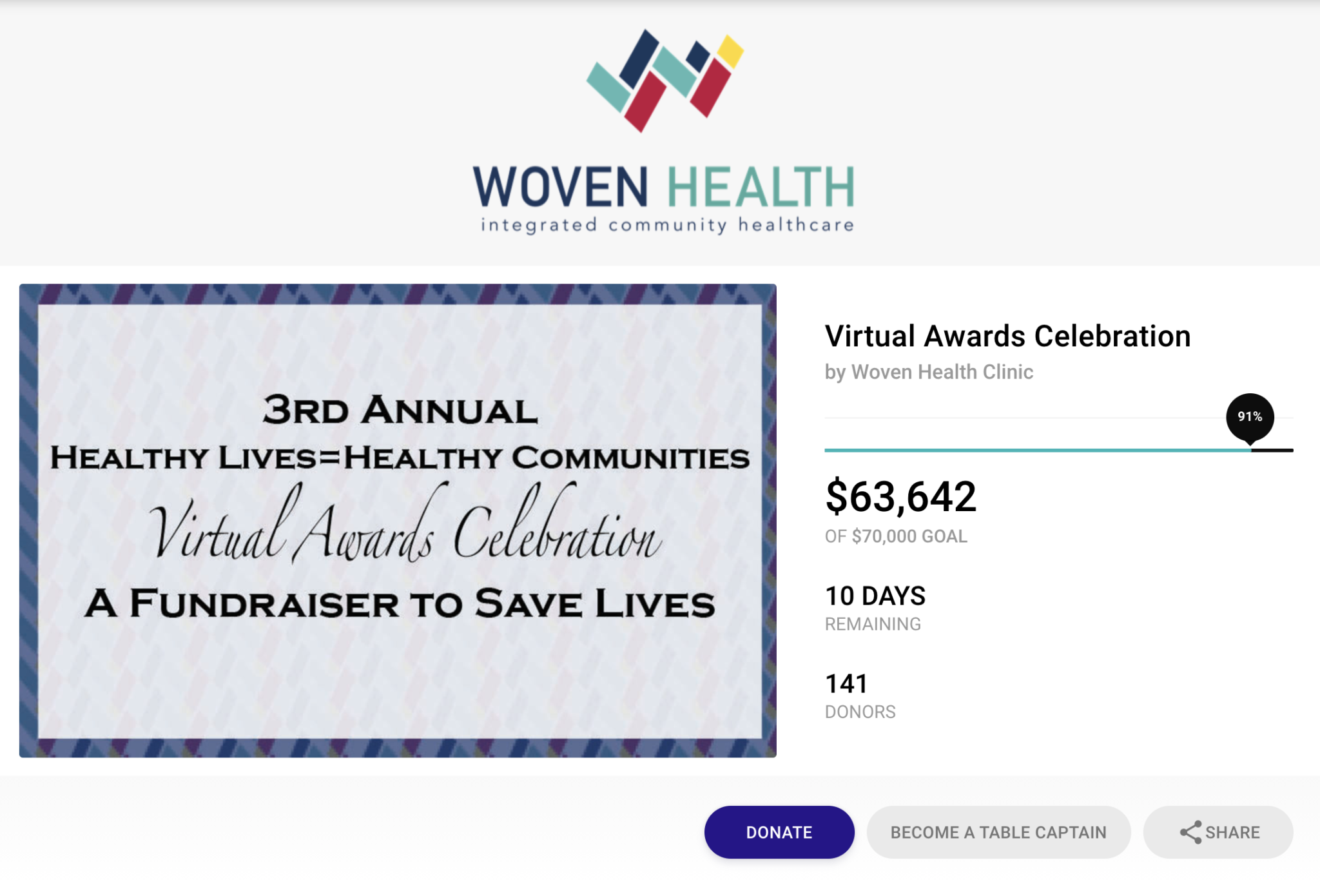
Woven Health Clinic is on their third year of hosting an awards ceremony fundraiser, but this year they did things a bit differently. As a healthcare clinic, COVID has made a huge impact on their work, and they weren’t afraid to share that in their campaign. They’re still leading up to their live stream event, but they’ve already raised 80% of their $70,000 goal.
Their event absolutely caught our attention and here’s why:
- Check out this picture that they shared: it’s hard to ignore. Woven Health wasn’t afraid to share the realities of how COVID has impacted them.
- They highlighted client testimonials to show the importance and benefits of their services.
- They made the ceremony more than simply fundraising: they included awards for two of their community members who have impacted their work.
Those things worked together to make the event a success, along with a few other key components:
- They used CauseVox’s peer-to-peer fundraising capabilities to give their fundraisers a solid foundation. They created a truly beautiful template for their fundraisers to use.
- They got some strong sponsors on their side and used CauseVox’s campaign page layout to highlight those sponsors.
- They truly focused on storytelling, both through images and through words. They didn’t need tons of photos, but a few well-placed photos of their team working during the pandemic made a huge impact.
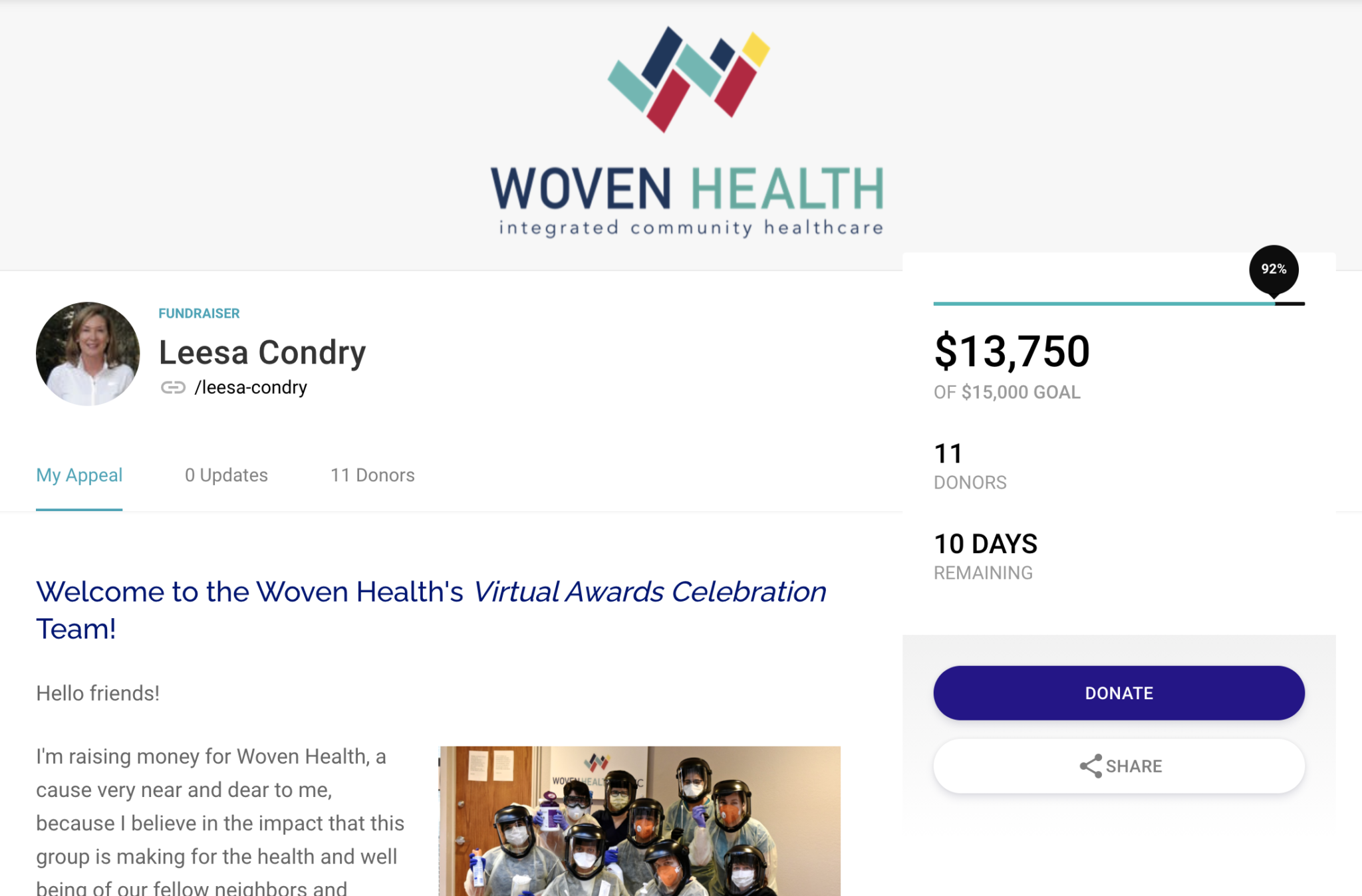
Virtual Challenges and Drives
One way to get your supporters really ramped up is to give them a challenge. People love to prove that they can come through and do what needs to be done. Challenges and drives can be almost anything, which is one of their strengths. They’re also a great way to build community and give your supporters something fun to do during COVID.
10. SOS Children’s Villages Illinois’ Holiday Giving Campaign
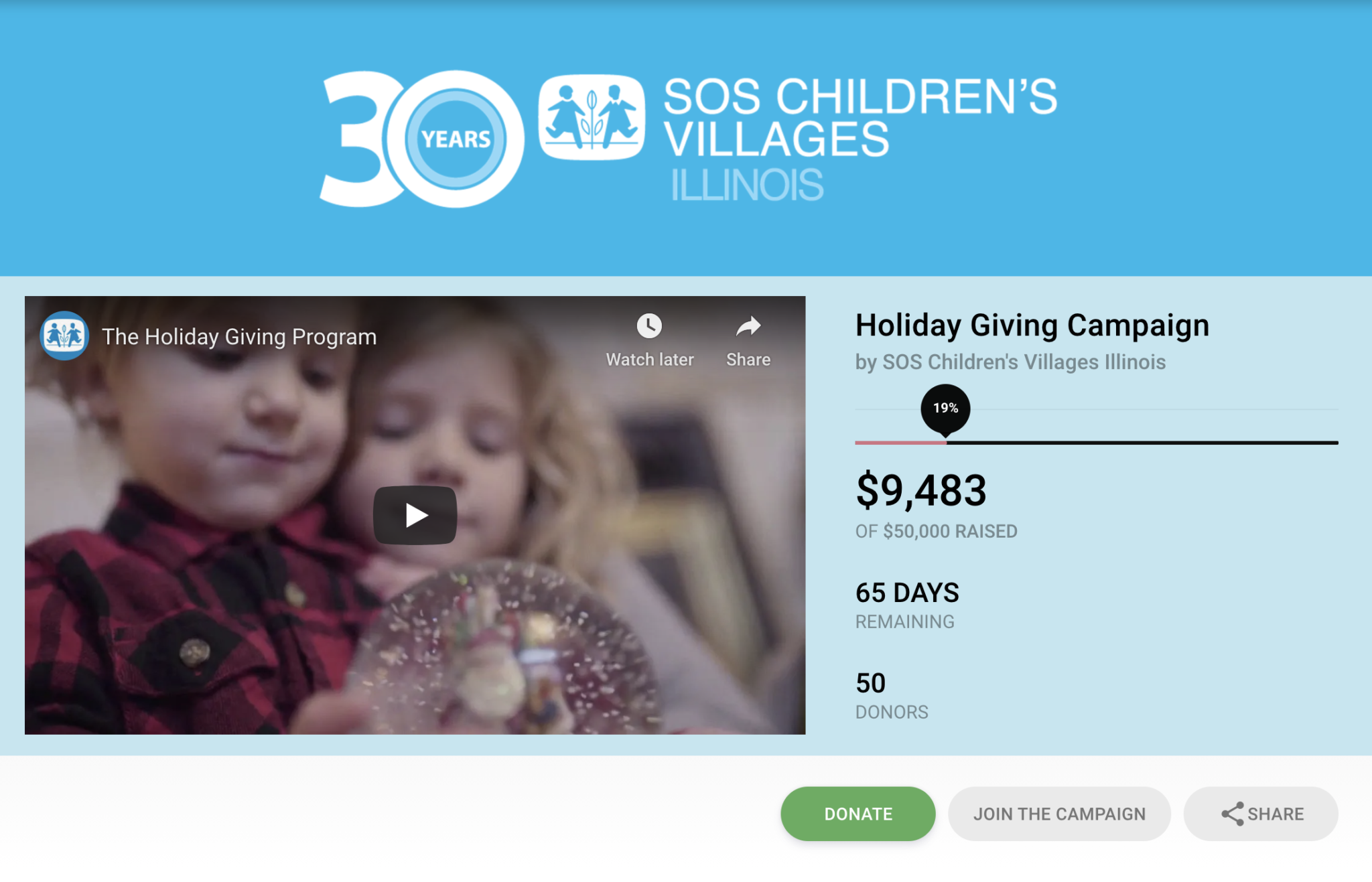
SOS Children’s Villages Illinois normally holds a toy drive during the winter months. This year, it wasn’t safe for supporters to drop off items, so they had to get creative. Instead of asking supporters to purchase toys and give them, they created a campaign to raise money so the organization itself could safely purchase and distribute items.
Their campaign is just ramping up and they’re already closing in on a fifth of the way to their goal.
Even though they’ve just launched, they’re already grabbing our attention with these stand out elements:
- They’ve clearly connected their campaign with the year-end and holiday giving. It makes it easier to see the timeliness of the need.
- They created concrete images of what they were doing by describing the toys and gifts they would give.
- They engaged corporate partners to participate in the virtual toy drive via Team fundraising pages.
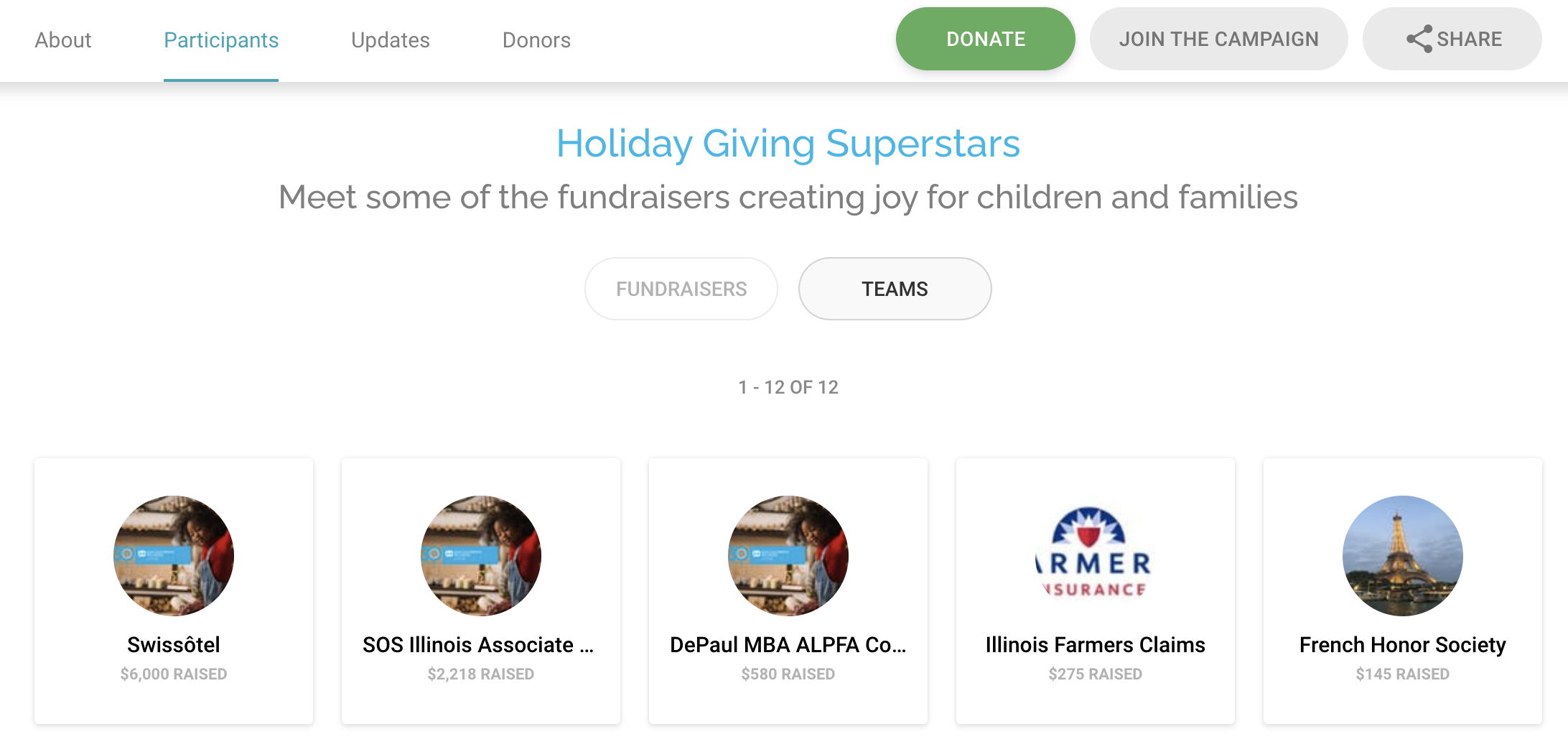
Those stand outs are part of why the campaign is doing so well, but it goes even further than that:
- They used their CauseVox customizable donation tiers to connect dollar amounts with gifts for children. When a donor came to the page, they could imagine what was going to go to a child because they saw the number of gifts listed right there.
- Not only did they show impact with donation tiers, they also showed a recipient. These donation tiers allowed donors to imagine who is receiving their gift.
- Their team is small but mighty. Currently they only have 11 teams and 10 individual fundraisers, but those fundraisers are doing the work. It’s not about how many people you have, it’s about who you have.
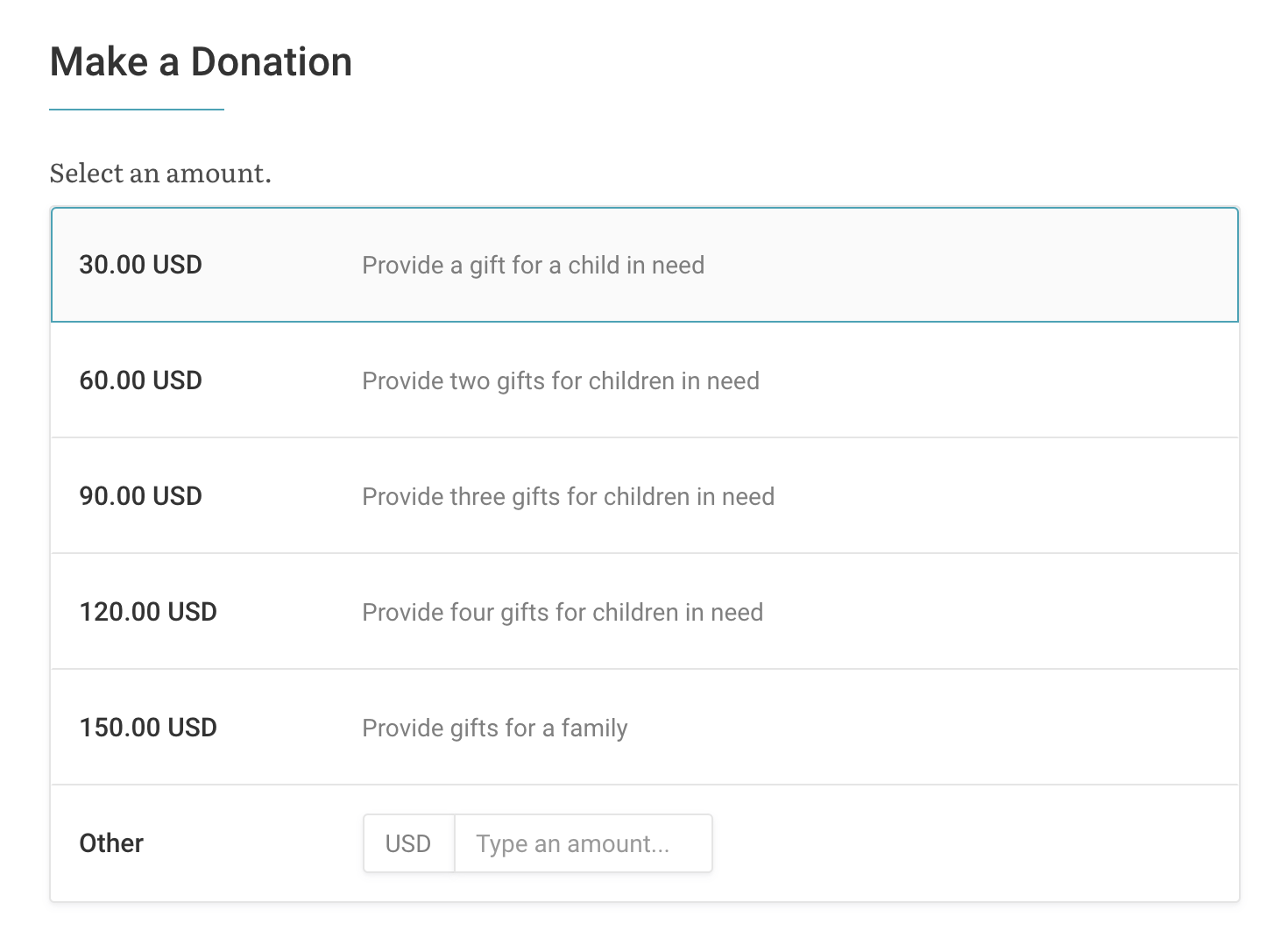
11. Nicholas House’s Sleep Out (Virtual Event) to Support Homeless Families 2020
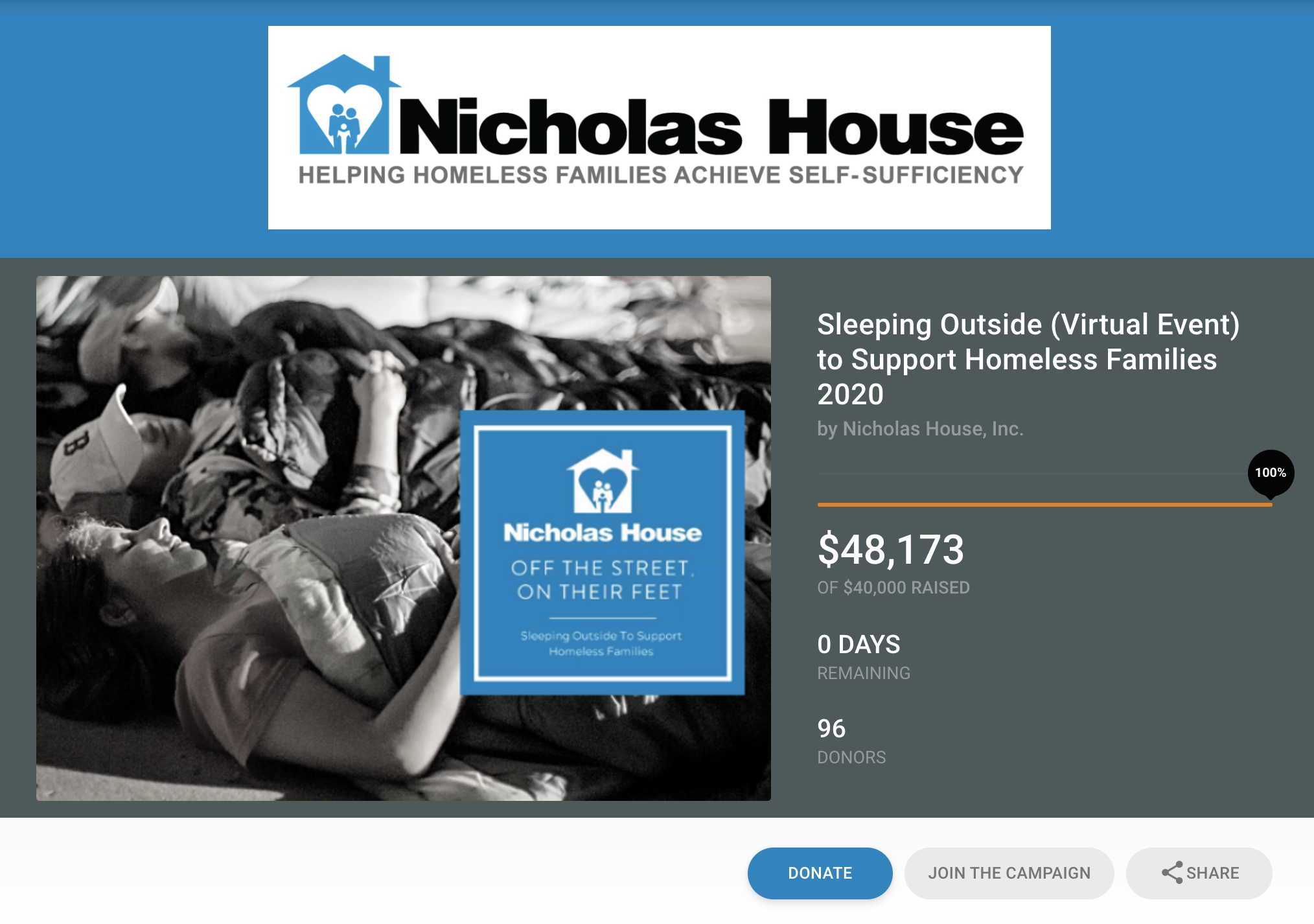
The annual sleepout is an incredibly creative event that makes a strong point to potential donors and stands out among the crowd. Typically, Nicholas House holds this event with all the participants together. That wasn’t an option this year, but luckily it’s an activity that translates well to social distancing. They asked folks to sleep outside for a night to raise money for homeless families.

They express it best themselves: “ Our goal is not to replicate the experience or pretend to be homelessness. For one night, we’re stepping outside our comfort zones to send a heartfelt message to homeless families that we care and want to help!”
They raised over $48,000 through the event, $8,000 more than their goal.
It stood out for a lot of reasons:
- The image of sleeping outside is very powerful and asks both participants and those around them to think about homelessness.
- Asking participants to do this in their own yards and spaces spreads the message incredibly effectively. Imagine you see your neighbors sleeping in their driveway: you’ll probably ask what they’re doing, and learn about the event.
- The public nature of the event makes it incredibly powerful.
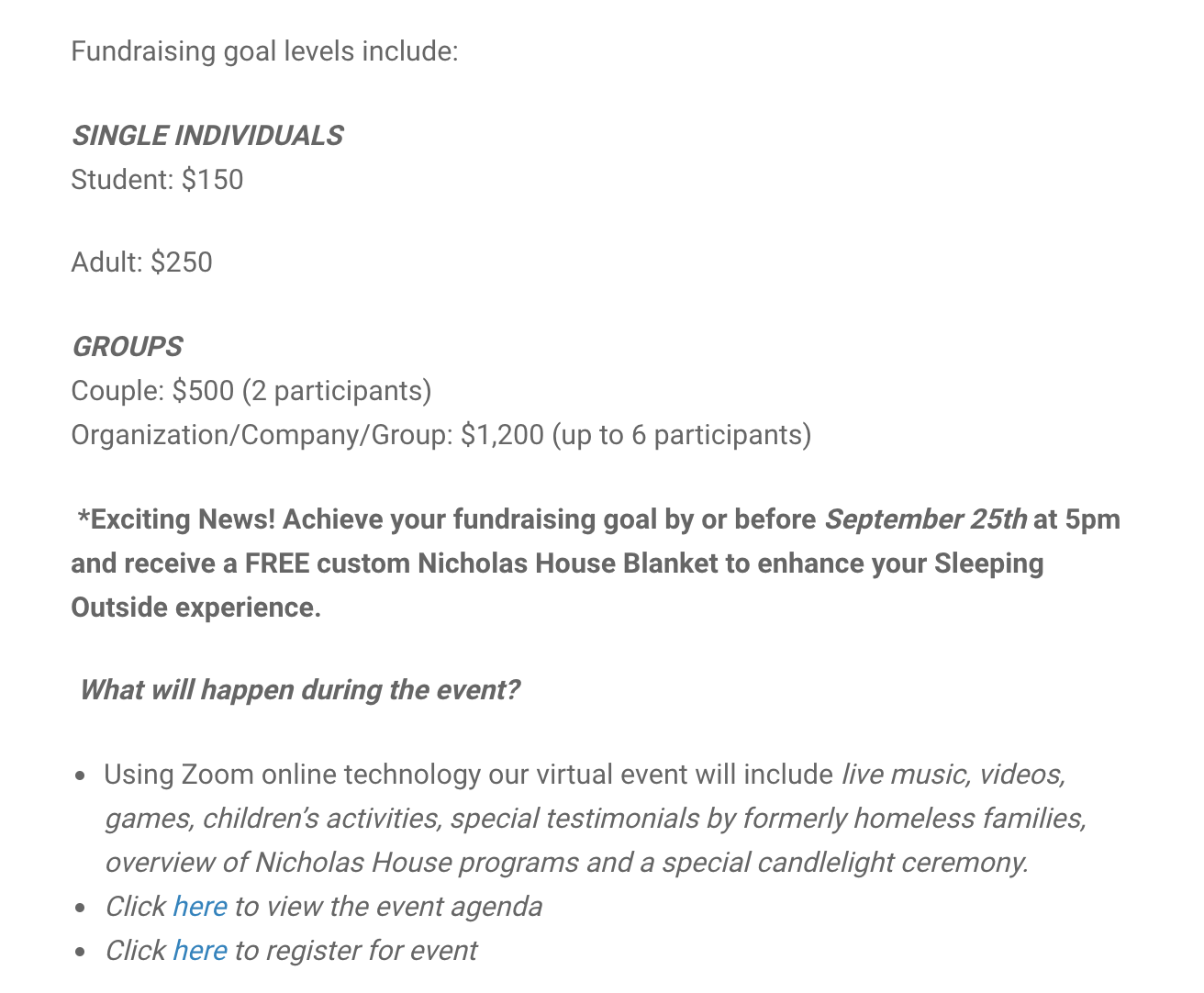
They also used some strong tactics to make the event successful:
- They asked fundraisers to hit certain goals and tailored those goals to different people. For example the student goal was $150, but the couples goal was $500. People who hit their goal got a blanket for their sleeping outside experience. You can set a default amount goal to make signup easier if you want to create goals for your fundraisers.
- They asked participants to share their experience on social media for added awareness and donations. Tagging them was a bonus!
- They had incredibly creative donation tiers: they found the exact dollar amount it took to cover certain services and used those as their tiers. CauseVox’s customizable tiers helped them to make this successful.
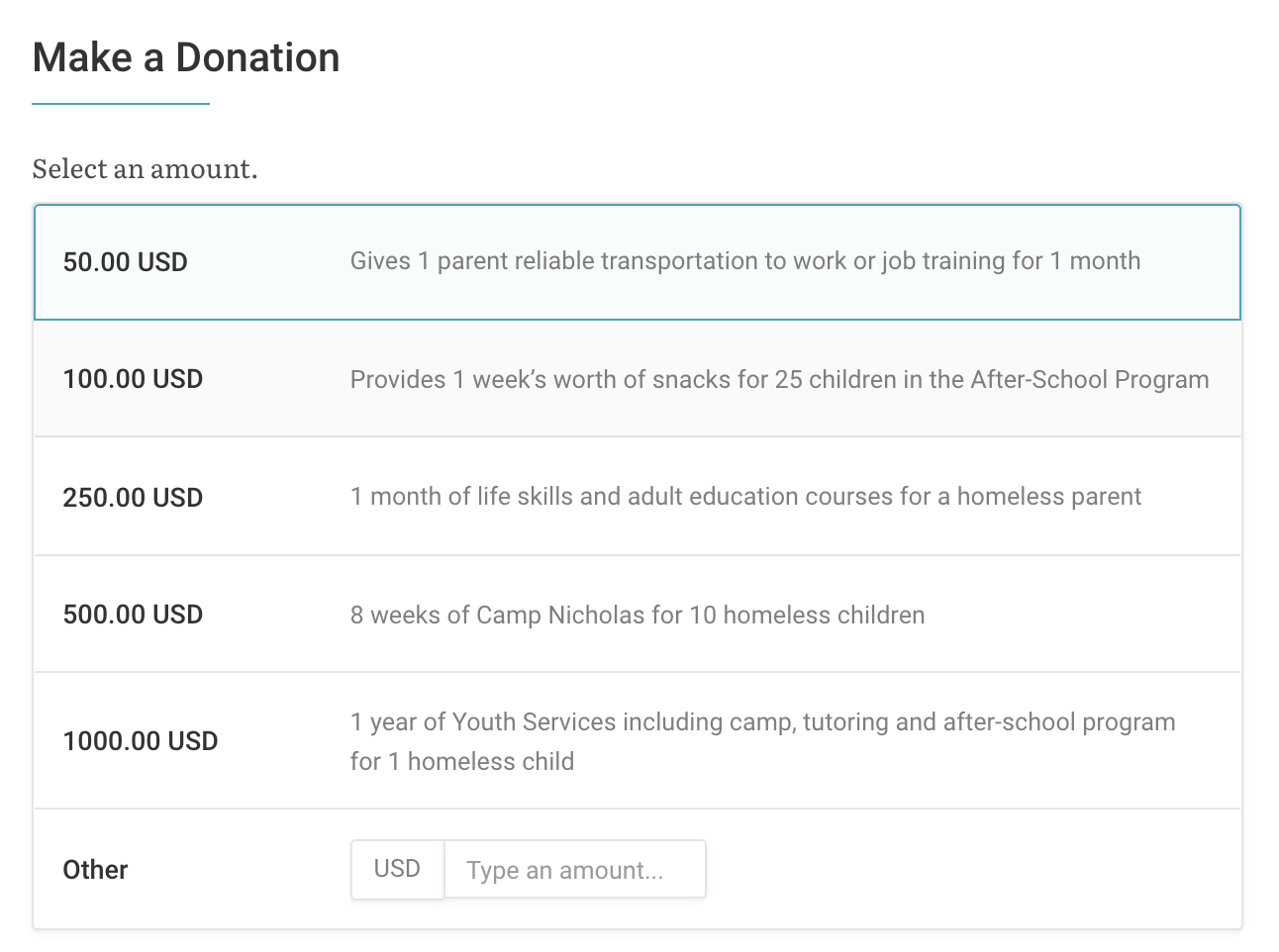
12. Mentor Colorado’s #Minute2Mentor Challenge
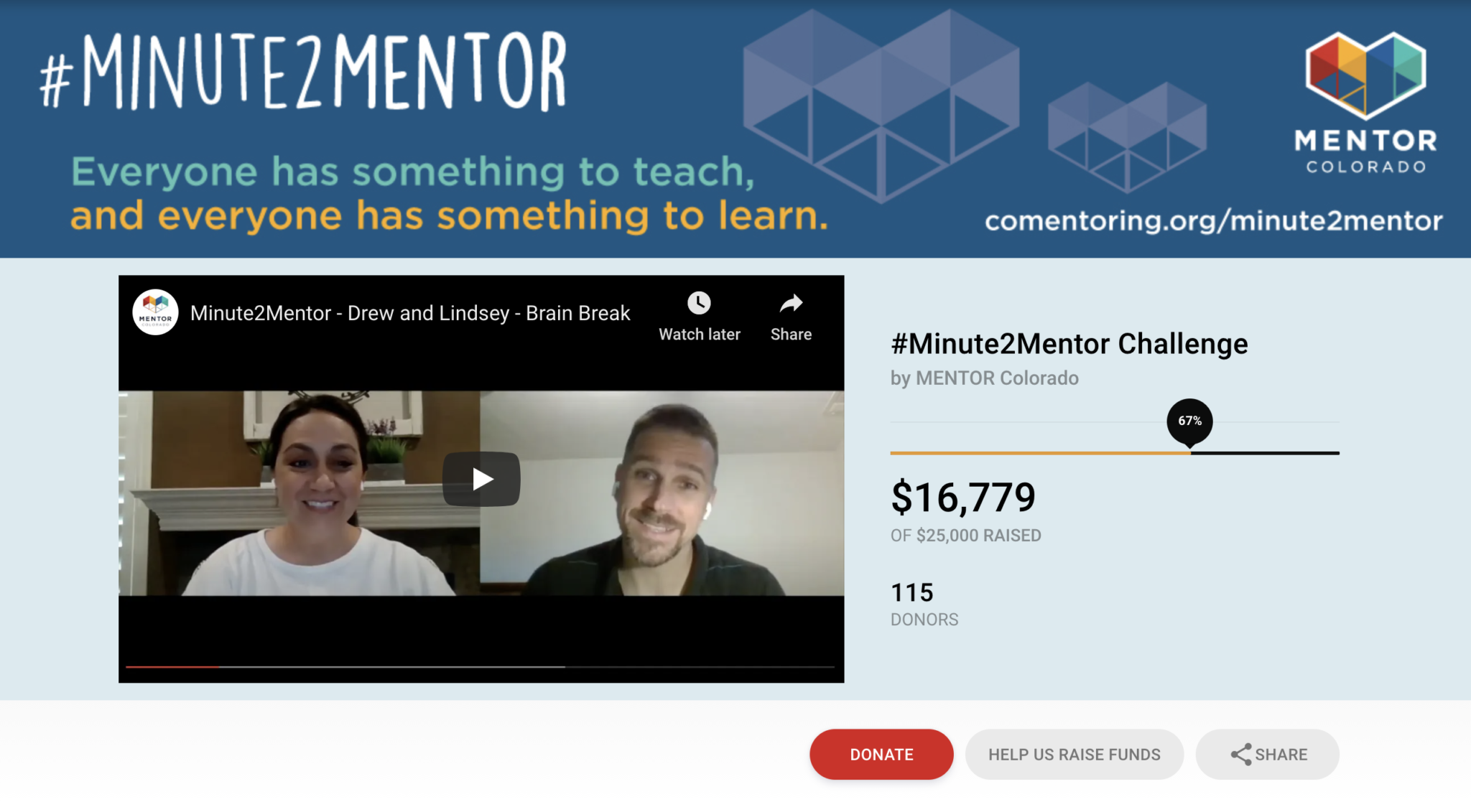
Let’s talk challenges. When we’re thinking about virtual fundraising, things like the ice bucket challenge might come to mind. Capitalizing on the viral nature of the internet is a powerful way to make your virtual fundraising effective. MENTOR Colorado did this by creating #Minute2Mentor. They asked supporters to create a one minute video sharing something they know that they wish other people knew, then share that video on social media with the hashtag.
The challenge isn’t over yet, but they’re over halfway to their goal.
We absolutely love this challenge idea for a few reasons:
- It’s super fun to create and share
- It helps people to feel smart and competent while helping out the organization
- It connects directly to their mission of mentorship and centers their story
With all of that it’s no surprise it’s an effective campaign. But there are a few more elements that help it to work:
- They made their awareness campaign even more powerful by finding a match. Donors will see a video from a friend or family member, notice that their dollars are doubled, and get inspired to donate.
- They used a clear and simple hashtag #minute2mentor to encourage lots of sharing. They used the hashtag to find videos they could share and bring more awareness.
- They shared examples so that supporters could feel confident in what they were doing.
- This was another case of finding the right people: with only 17 fundraisers, they’re already over $16,000 and their campaign isn’t complete yet.
13. North Texas Food Bank’s Peanut Butter Drive
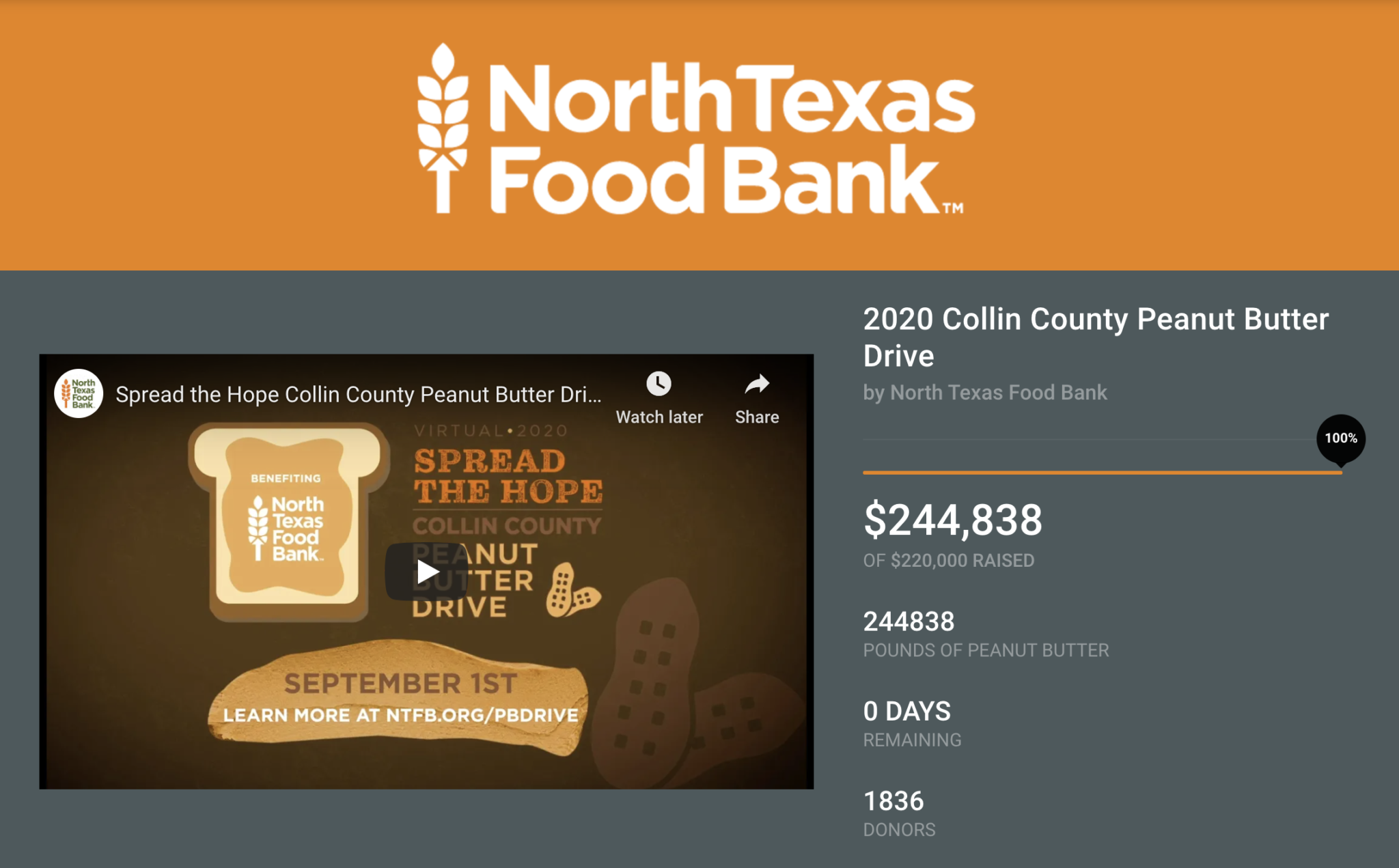
Every year North Texas Food Bank (a certified member of the Feeding America Food Bank Network) does a drive to collect peanut butter and lots of it. One of the cool things about the event is that this year they didn’t have to change too much: donating peanut butter is already social distance friendly. In addition, they raised funds to support the food bank and feed hungry kids.
They surpassed their goal by $44,000, which is absolutely amazing. On top of that, they collected and dispersed at least 200,000 pounds of peanut butter (they haven’t shared the final numbers yet).
Here’s what stood out to us:
- The two pronged approach: they were asked for both monetary donations and a physical item.
- They used peanut butter to educate supporters about childhood food insecurity: for example I learned that peanut butter is a great option to donate because it doesn’t go bad and it’s high in protein!
It’s also been wildly successful, and here’s why:
- They got local government involved: in their intro video they have a conversation with local mayors to talk about the importance of the drive. The buy-in really shows donors that it’s important.
- That two-pronged approach we mentioned? They used it to their benefit. Most of us have an unopened jar of peanut butter in the cupboard, and it’s easy to donate that. The easy food donation allowed the food bank to start communicating with folks about the importance of a monetary donation as well.
- They got companies involved. Check out this screenshot: they connected with some great businesses and organizations and encouraged them to set up teams. Those group fundraisers were incredibly successful.
Make the Switch to CauseVox
Want to implement your own virtual fundraising campaign?
CauseVox makes it easy for you to run all your digital and virtual fundraising, helping you raise more with less effort in this uncertain time.
Even better, CauseVox’s Basic Plan is free to help support all nonprofits during this pandemic.
Get started today for free with CauseVox.
Book your free Virtual Fundraising Consultation with an expert.




